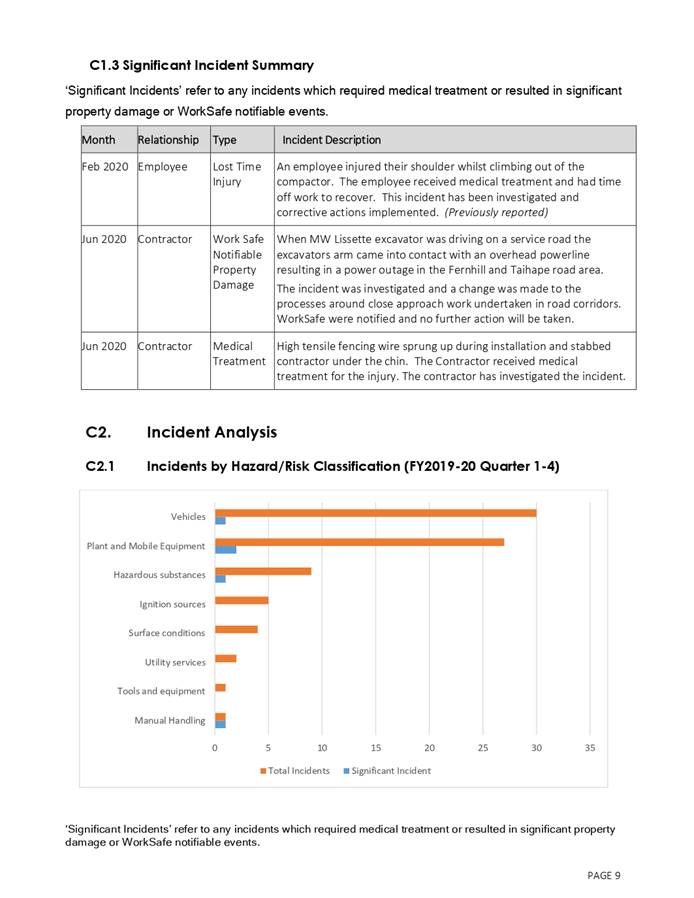Kaupapataka
Open Agenda
|
Te Rā Hui:
Meeting date:
|
Friday, 25 September
2020
|
|
Te Wā:
Time:
|
1.00pm
|
|
Te Wāhi:
Venue:
|
Council Chamber
Ground Floor
Civic Administration
Building
Lyndon Road East
Hastings
|
|
Te Hoapā:
Contact:
|
Democracy
and Governance Services
P: 06 871 5000
| E: democracy@hdc.govt.nz
|
|
Te Āpiha Matua:
Responsible Officer:
|
Waste & Data Services Manager - Martin Jarvis
|
OMARUNUI
REFUSE LANDFILL JOINT COMMITTEE HEADS OF AGREEMENT – Terms of Reference
The Heads of Agreement for the Omarunui
Refuse Landfill Joint Committee have been adopted by Council for the 2019-2022
Triennium and are incorporated into the Committee
& Rural Community Board Register of Delegations.
|
1.
|
Parties
|
Hastings District Council and Napier
City Council (the Councils)
|
|
2.
|
Nature of
Relationship
|
A Joint Committee between the Councils
who already own a property at Omarunui as tenants in common in the following
shareholding percentages for refuse disposal purposes:
Hastings District Council: 63.68%
Napier City Council: 36.32%
|
|
3.
|
Objectives
|
To jointly develop and operate generally
for the benefit of the Councils a refuse disposal facility (including any
ancillary activities) in compliance with resource and regulatory consents.
|
|
4.
|
Participation
of each Council
|
Each Council shall participate on the
basis of the following shareholding percentage:
Hastings District Council: 63.68%
Napier City Council: 36.32%
(subject to any specific provisions following)
|
|
5.
|
Joint
Committee
|
|
|
5.1
|
Omarunui
Refuse Landfill Joint Committee (Joint Committee):
|
This Committee shall comprise four
elected members of the Hastings District Council and two elected members of
the Napier City Council or the alternates of those elected members and an
alternate when acting in the place of an elected member shall be deemed to be
an elected member. The functions of this Joint Committee shall be to
determine policies to ensure the objectives are achieved and to monitor the
implementation of those policies by obtaining reports from the Facility
Manager or any other persons involved in the refuse disposal operation.
|
|
5.2
|
Administering
Authority
|
The Hastings District Council shall be
the Administering Authority. It shall provide technical, financial and
secretarial services and shall be the employing authority for staff required
in the administration and conduct of the refuse disposal operation. The
Administering Authority shall make any information required by the Joint
Committee available to that Committee.
|
|
6.
|
Joint
Committee General Powers
|
1.1 Subject
to Clause 6.2 the general powers of the Joint Committee shall be:
a) Except
as provided in Clause 6.3 all such powers as shall be necessary to develop
and operate the refuse disposal facility in compliance with the resource and
regulatory consents already obtained including, if necessary, the power to
seek further resource and regulatory consents.
b) To
construct buildings, purchase and dispose of plant, equipment and materials.
c) Arrange
insurance cover to ensure that there is comprehensive insurance in respect of
the establishment and operation of the refuse disposal facility.
d) To
indemnify any Council or Council representative acting on behalf of the
Councils pursuant to this agreement in connection with the development or
operation of the refuse disposal operation after the execution hereof.
e) To
fix and recover fees and charges payable by landfill users.
f) The
licensing of users.
g) To
recommend to the Councils the raising of loans. For the purpose of loan
raising the ‘Administering Authority’ shall undertake all loan
raising on behalf of the Councils.
h) To
enter into contracts within the estimates it being acknowledged by each of
the Councils for the purposes of the Local Government Act 2002 that the Joint
Committee shall be delegated power to enter into any contract limited to such
an amount as may be fixed by the Councils from time to time unless the prior
written approval of each Council shall have been obtained.
i) Toi
use any part of the Omarunui property not required for refuse disposal for
any lawful purpose including leasing thereof.
j) Such
further specific powers as may be delegated to it as agreed by the Councils.
1.2 The
Joint Committee shall operate within budgets approved by the Councils. In the
event that over expenditure is anticipated or incurred the Joint Committee
shall immediately report that fact to the Councils.
1.3 The
powers delegated to the Joint Committee shall not entitle that Committee to
sell or otherwise dispose of on behalf of any Council any asset owned by that
individual Council or to sell the Omarunui land or any other land
administered by the Joint Committee for refuse disposal purposes.
1.4 Subject
to Clause 6.2 and 6.3 all decisions made by the Joint Committee pursuant to
its delegated powers shall without confirmation of the Councils bind each of
the Councils as if it had been done in the name of each Council.
|
|
7.
|
Joint
Committee Procedural Matters
|
7.1 Each elected member or the
alternate of such member shall have one vote.
7.2 The
elected members shall elect a Chair and Deputy Chair.
7.3 Quorum
at meetings shall be four elected members including at least one elected
member from each Council. The parties note that this conflicts with the provisions
in clause 30 (9) (b) of schedule 7 of the Local Government Act 2002. To avoid
any possible doubt the parties shall operate the committee based on the
specific requirements in this agreement at all times.
7.4 All
meetings may be attended by officers of the Councils but officers shall not
be entitled to vote.
7.5 Meetings
may be requisitioned by any two elected members who shall state the nature of
the business and the Administering Authority shall convene a meeting (giving
notice of the business) and Councils shall ensure that at least one of their
elected members attends.
7.6 Annual
meetings shall be held within three months of the end of the financial year
and the business of such meeting shall include the financial accounts for the
previous year.
7.7 Budget
estimates for the following financial year shall be prepared and supplied to
the Councils no later than 31 January in each year for their approval.
7.8 Meeting
procedures shall be in accordance with NZS 9202: 2003, or such other version
of standing orders as mutually agreed between the parties, except to the
extent that specific provision is contained herein and is not contrary to
law.
|
|
8.
|
Joint
Committee Financial Provisions
|
8.1 The
Joint Committee shall provide financial and management accounting records and
reports which provide sufficient detail to enable the committee and the
Councils to assess performance of each separate business activity within the
Landfill.
8.2 The
administering authority shall circulate a draft budget prior to the meeting at
which the Joint Committee is to consider the estimates for recommendation to
the Councils.
8.3 Surpluses
and deficits shall be received and borne by the Councils in the following
shareholding percentage:
Hastings
District Council: 63.68%
Napier City Council: 36.32%
8.4 All amounts payable by each Council shall be
paid within one calendar month of notification of the amount payable. If any
Council shall consistently fail to make payments as required by this clause
the Joint Committee may impose a penalty on the defaulting Council which
shall be met by such Council.
|
|
9.
|
Duties of the
Individual Councils
|
9.1 To
comply with the resource and regulatory consents relating to the operation.
9.2 The
Councils shall make bylaws to ensure the efficient operation of the refuse
disposal facility and set and adopt fees and charges and licensing
procedures.
9.3 To establish and operate transfer stations and
to adopt charges in relation to such transfer stations.
|
|
10.
|
Changes in
Participation
|
1.1 The
establishment and operating costs of the Councils up to the time of any
Change in Participation shall be safeguarded as far as possible.
1.2 The
addition or withdrawal of any party shall require agreement of the Councils.
|
|
11.
|
Staff
Appointments
|
11.1 Where
any Council is involved in the provision of staff or services, such Council
shall be reimbursed for the cost of such persons or services.
11.2 It is recognised that it will be desirable for
the staff required to be employed by one of the Councils.
|
|
12.
|
Facility
Manager
|
12.1 The
Facility Manager appointed by the Administering Authority shall be a suitably
qualified person who shall report to the Joint Committee and attend its
meetings and will be responsible for the day to day operations at the
landfill site.
12.2 During
any further development the Facility Manager, as appointed by the
Administering Authority, shall be considered to be the officer responsible
for all development activities unless otherwise directed by the Joint
Committee.
|
|
13.
|
Secretarial
Services
|
13.1 Secretarial
and Accounting services shall be provided by the Administering Authority.
13.2 The
functions to be fulfilled shall include:
a) Convening
of meetings.
b) Keeping
of minutes.
c) Preparation
of estimates and accounts.
d) Keeping
the Joint Committee informed.
e) The
recovery of fees and charges.
f) Such
further specific powers as may be delegated by agreement of the Councils.
13.3 All
documents to be signed on behalf of the Joint Committee shall be signed by
the Chair (or in his absence one elected member of that Committee) together
with such other person authorised by the Administering Authority.
|
|
14.
|
Commencement
and Duration
|
14.1 This Joint
Committee shall commence from the date of this agreement and shall continue
thereafter until terminated by agreement of the Councils.
14.2 On
termination of this agreement the assets shall be applied, first, in the
repayment of all debts, second, in the repayment of any capital
contributions, advances or sums of money that may have been made or may be
due to any of the Councils, third, the surplus, if any, shall be distributed
between the Councils in the following shareholding percentage:
Hastings
District Council: 63.68%
Napier City Council: 36.32%
14.3 In the
event of a short-fall on the termination of this agreement the Councils shall
contribute in the following shareholding percentage:
Hastings
District Council: 63.68%
Napier City Council: 36.32%
To
such short-fall, with any necessary adjustments being made to reflect any
amounts due by or to any individual Council at termination.
|
|
15.
|
Arbitration
|
15.1 In the
event of any dispute relating to this agreement the same shall be referred to
arbitration pursuant to the Arbitration Act 1996 and each Council who is a
party to the dispute shall be entitled to appoint an Arbitrator.
15.2 The
Arbitrators before embarking on the Arbitration shall appoint an umpire whose
decision shall be final in the event that the Arbitrators are unable to
agree.
|
Kaupapataka
Open Agenda
|
Nga mema o te Komiti
Committee Members:
|
Heamana
Chair: Councillor Ann Redstone (HDC)
Councillors Damon Harvey, Simon
Nixon and Sophie Siers (HDC)
Councillors Richard McGrath and Api Tapine (Deputy Chair)
(NCC)
HDC Alternate: Councillor Eileen Lawson
NCC Alternate: Deputy Mayor
Annette Brosnan
|
|
Tokamatua:
Quorum:
|
4 - including at least one
elected member from each Council
|
|
Apiha Matua
Officer Responsible:
|
Waste and Data Services Manager -
Martin Jarvis
|
|
Te Rōpū Manapori
me te Kāwanatanga
Democracy & Governance Services
|
Christine Hilton (Ext 5633)
|
Te Rārangi Take
Order of Business
|
1.0
|
Apologies
& Leave of Absence – Ngā Whakapāhatanga me te Wehenga ā-Hui
At the close of the agenda
no apologies had been received.
At the close of the agenda
no requests for leave of absence had been received.
|
|
|
2.0
|
Conflict
of Interest –
He Ngākau Kōnatunatu
Members need to be vigilant to stand aside from
decision-making when a conflict arises between their role as a Member of the
Council and any private or other external interest they might have.
This note is provided as a reminder to Members to scan the agenda and assess
their own private interests and identify where they may have a pecuniary or
other conflict of interest, or where there may be perceptions of conflict of
interest.
If a Member feels they do have a conflict of interest,
they should publicly declare that at the start of the relevant item of
business and withdraw from participating in the meeting. If a Member
thinks they may have a conflict of interest, they can seek advice from the
General Counsel or the Manager: Democracy and Governance (preferably before
the meeting).
It is noted that while Members can seek advice and
discuss these matters, the final decision as to whether a conflict exists
rests with the member.
|
|
|
3.0
|
Confirmation
of Minutes –
Te Whakamana i Ngā Miniti
Minutes of the
Omarunui Refuse Landfill Joint Committee Meeting held Friday 19 June 2020.
(Previously circulated)
|
|
|
4.0
|
Health
and Safety Report
|
9
|
|
5.0
|
Proposed
Education Building
|
19
|
|
6.0
|
Omarunui
Joint Landfill Annual Report for the Year Ending 30 June 2020
|
25
|
|
7.0
|
Annual
Review of Hedging Strategy for Landfill Carbon Emissions
|
51
|
|
8.0
|
Discussion
Document regarding the possible introduction of material-specific pricing at
Omarunui Landfill
|
61
|
|
9.0
|
Minor Items
– Ngā Take
Iti
|
|
|
10.0
|
Urgent
Items –
Ngā Take Whakahihir
|
|
Hastings
District Council: Omarunui Refuse Landfill Joint Committee Meeting
Te Rārangi Take
Report to Omarunui Refuse Landfill Joint Committee
|
Nā:
From:
|
Nikola Bass, Health
& Safety Partner
|
|
Te Take:
Subject:
|
Health and Safety Report
|
1.0 Executive Summary
– Te Kaupapa Me Te
Whakarāpopototanga
1.1 The
purpose of this report is to inform and update the Joint Committee about Health
and Safety at Omarunui Refuse Landfill.
1.2 The
Health and Safety at Work Act 2015 (HSWA) requires HSWA Officers (Elected
members and Chief Executives) to exercise due diligence by taking reasonable
steps to understand the organisation’s operations and Health and Safety
risks, and to ensure that they are managed so that Councils meet their legal
obligations.
1.3 Whilst
Hastings District Council HSWA Officers are provided with regular health and
safety reports in order to assist them in meeting their governance obligations.
It is recognised that Napier City Council’s Elected Members are also
members of this Joint Committee and therefore the attached report (Attachment 1)
provides information to enable all Joint Committee Members to undertake due
diligence, by providing leading and lagging statistical information in relation
to Health and Safety for the period 1 January 2020 to 30 June 2020.
|
2.0 Recommendations
– Ngā Tūtohunga
A) That the Omarunui
Refuse Landfill Joint Committee receives the report titled Health and Safety
Report.
|
Attachments:
|
1⇩
|
Human Resources (NO PERSONAL INFORMATION) - Health and
Safety - General - Health and Safety Report to Omarunui Refuse Landfill Joint
Committee - 01 January 2020 - 30 June 2020
|
HR-03-01-20-342
|
|
|
Human
Resources (NO PERSONAL INFORMATION) - Health and Safety - General - Health
and Safety Report to Omarunui Refuse Landfill Joint Committee - 01 January
2020 - 30 June 2020
|
Attachment 1
|





Hastings
District Council: Omarunui Refuse Landfill Joint Committee Meeting
Te Rārangi Take
Report to Omarunui Refuse Landfill Joint Committee
|
Nā:
From:
|
Sam Gibbons, Senior
Waste Minimisation Officer
|
|
Te Take:
Subject:
|
Proposed Education
Building
|
1.0 Executive Summary
– Te Kaupapa Me Te
Whakarāpopototanga
1.1 The
purpose of this report is to inform the committee of an opportunity to use
recovered building materials from Henderson Road Refuse Transfer Station and
Omarunui Landfill to build a Sustainable Education Centre out at Omarunui
Landfill. Providing the chance to improve our landfill tours, increase the
engagement of our community and their understanding of what happens to our
waste and through this empower them to reduce their waste.
1.2 This report seeks
support from the committee to allocate up to $2000 from existing landfill
budgets to scope the work and estimate the cost of building an Education
Building. This will take into account the materials available and how these can
be incorporated into a basic design to provide a cost to build the centre.
|
2.0 Recommendations – Ngā Tūtohunga
A) That the Omarunui
Refuse Landfill Joint Committee receives the report titled Proposed Education
Building.
B) That the
Committee support further investigation by the Waste Team and Landfill into
the building of an Education Centre and approve the allocation of up to $2000
from existing landfill budgets to develop a more detailed scope of work and
cost estimates for the project.
|
3.0 Background – Te Horopaki
3.1 The Joint Waste
Management and Minimisation Plan for 2018-2024 focuses on our need as a
community to divert more materials from landfill and provide education on why
this is important and how we can all play our part in making landfill our last
choice.
3.2 Both Hastings District
Council and Napier City Council waste minimisation teams currently provide
educational tours for schools, businesses, and the public to the landfill. The
construction of an education centre at the landfill would enable an increase in
the number of tours and provide a designated educational and meeting space
where a more in depth understanding of the community’s waste can be
gained, and it would also provide the option to run them all year round.
3.3 An opportunity has arisen
to use recovered building materials that have been brought into Henderson Road Refuse
Transfer Station and Omarunui Landfill that would have otherwise been disposed
of in the landfill and taken up valuable space. As the recovered material will
deteriorate with time it would be preferable to use what has been collected to
date either this year or next financial year at the latest.
3.4 With the landfill levy
increasing over the next few years our community is going to be paying more and
more for its waste. By providing improved education on what happens to our
waste and how it can be reduced at school, at home, at work and out in the
community we can help reduce what goes to landfill. Saving money for our
community and extending the life of its landfill.
4.0 Discussion – Te Matapakitanga
4.1 One of the actions to
come out of the Joint WMMP looks at improving education provided to our
community:
7. A
EDUCATION Empower
residents, service users and communities to prioritise (and increase) efforts
regarding waste reduction, resource recovery and work towards zero waste via a
consistent education programme across Napier City and Hastings District. Expand
further across Hawke’s Bay where practicable.
4.2 The most impactful
thing you can do is to take someone to the landfill to be confronted with their
waste and the waste of the community. To see it be pushed into the ground and
face the grim reality that we are filling the earth with it. Although many
people feel reassured to see that the landfill is well managed, it is clear
that this is not the ideal solution for our growing waste problem. People who
have been on tours have spoken of how eye opening the experience was to see just
how much waste we produce.
4.3 As impactful as a tour
is, we are failing to capitalise on these new found emotions to take action and
make a change. Conversations during the tour focus mainly on the workings of
the landfill with brief chats here and there on what you can do to reduce
waste. With the variable weather conditions and high winds that can occur it is
not a place to engage in the next part of the discussion. The outdoor
environment means not everyone can hear clearly and group sizes need to remain
smaller to account for this. There is also no way to display information for
everyone to see, to help highlight points that are made during the tour. There
is a lot of information given during the talk that can be quite hard to
visualise and could be better explained with the aid of videos and example
models and materials.
4.4 Building an education
centre would help tackle all of these issues and provide opportunities to
increase education beyond the current tour format. Screens could show live
camera streaming of the tip face, as from the view point the tip face is often
hidden depending on work being carried out at the time and it is the one area
that often people most want to see. Interactive displays could explain
different aspects of the landfill and what happens to it over time, as well as
materials that are used during construction to ensure the effects of the
landfill on ground water and the environment are mitigated. Within the
education centre as part of the tour we can host a short session on next steps
individuals and communities can take to reduce their impact. This would help
everyone to truly get the most out of each visit.
4.5 Schools are busy
places, so taking time to get a class out to landfill can be challenging, being
able to combine a tour with a lesson carried out in our interactive teaching
space would make the trip much more worthwhile and the cost to run a bus much better
value. There are many different topics schools could tap into from the
environmental impact, to looking at the science behind the landfill monitoring
and its effects, to the engineering and construction aspects and the general
long term site management. Expanding to these different topics would also
provide an opportunity to extend our service to secondary and tertiary
education, which are currently not catered for with the current tour model.
4.6 The education centre would
be used for events and educational workshops through the waste minimisation
team initiatives, as well as through our partners such as the Environment
Centre, Enviroschools and Para Kore. It could provide a space for a variety of
EIT programmes that fit with the learning opportunities available at landfill.
4.7 A key consideration is
that the existing materials that have already been recovered will potentially degrade
if we do not start to use them in the near future. Currently the landfill has
approximately 500 tonnes of materials that could possibly be diverted with
multiple benefits. All materials will be checked and certified to make sure
they are safe and meet design standards. These materials have the potential to
reduce the building costs by around $60,000 to $100,000.
4.8 Omarunui Landfill has
already used recovered materials that have been cleaned and certified to upgrade
the kitchen, toilets / shower room and create a changing room for landfill
staff.



Workshop before New
Smoko room under construction and finished
4.9 Additionally the
design and build of the building will incorporate (as much as possible) aspects
that make this education centre a sustainable and carbon neutral building to
show council’s commitment to progressive procurement practices where the
environmental impact of a construction is considered.
4.10 Examples of things that may be
incorporated would be: solar power, composting toilets, double glazing,
insulation and the use of locally sourced materials. This may have a slightly
higher initial cost but savings from power could help offset operational costs
over the life of the building.
4.11 It is proposed that we would build this
at Area B which we are due to move into in 4-5 years and would be actively
filling for the following 30-40 years.
4.12 Both the Hastings District and Napier
City Council Waste Teams fully support the proposal to build an education space
at landfill and can see the number of benefits that this would bring to the
community and our partners the Environment Centre, Enviroschools and Para Kore.
The waste teams would work together to plan, design and implement the project
and work towards ticking off another task that was set in the WMMP.
5.0 Options – Ngā Kōwhiringa
Option One
5.1 Support in principle
the building of an education centre at landfill and further investigation by
the Waste Team. This would include funding a builder xx amount to price up an
estimated cost of the build taking into account the recovered materials
available on site.
Advantages
· Alignment with the
WMMP
· Provide an
education space designed to engage with our community
· Provide a facility
to undertake tours year round
· Potential to extend
the life of the landfill though better education
· Would be a great
place to showcase Councils commitment to environmental sustainability
· Council adhering
to sustainable building guidelines and leading the way in how we expect the
community to reuse materials
· Could potentially
be a Carbon Neutral project/building
Disadvantages
· Cost, as an
unbudgeted project for this financial year
Option Two - Status Quo - Te Kōwhiringa Tuarua
– Te Āhuatanga o nāianei
5.2 Do not proceed with
further investigation into the building of a Sustainable Education Centre.
Advantages
· No need to create
a budget for this work i.e. no additional costs to the landfill
Disadvantages
· Not maximising the
impact and effectiveness of landfill tours or investing in the future education
of the community
· Lost opportunity
to showcase Councils commitment to environmental sustainability
· Not making use of
materials that could be reused. This would result in materials collected
to date being permanently landfilled.
6.0 Next steps – Te Anga Whakamua
6.1 Should the committee
approve in principal the construction of an education centre, both Council
waste teams will finalise the sustainable features to be included the building
design, arrange an estimate for the work with the materials available.
6.2 This initiative will
also be shared at the next Joint Waste Futures Project Steering Committee,
meeting date to be confirmed.
6.3 Present a further
report on the matter at the Landfill Committee meeting scheduled for 4th
December with an estimated building cost and funding proposal.
6.4 Should the Landfill
Committee approve of the project at the 4th December meeting, and
depending on the chosen funding mechanism, it is most likely that ratification
would need to be obtained from the parent Councils to progress the project.
Attachments:
There are no attachments for this report.
|
Summary of
Considerations - He Whakarāpopoto Whakaarohanga
|
|
Fit
with purpose of Local Government - E noho hāngai pū ai ki te
Rangatōpū-ā-Rohe
The Council is required to give effect to the purpose of
local government as set out in section 10 of the Local Government Act 2002.
That purpose is to enable democratic local decision-making and action by (and
on behalf of) communities, and to promote the social, economic,
environmental, and cultural wellbeing of communities in the present and for
the future.
Link to the Council’s
Community Outcomes – Ngā Hononga ki Ngā Putanga ā-Hapori
This proposal promotes the local public
services wellbeing of communities in the present and for the future
supporting a community which wastes less.
|
|
Māori
Impact Statement -
Te Tauākī Kaupapa Māori
This project provides an opportunity to
work with the Ngāti Pārau Hapū Trust and incorporate their
history into the development.
|
|
Sustainability
- Te
Toitūtanga
The proposed education building would
ideally be as sustainable as possible. The building would incorporate the
reuse of materials that would’ve otherwise been buried in landfill.
With the remaining materials sourced locally and the addition of sustainable
features such as solar power, compostable toilets and good insulation. It
would be great to work out the carbon impact of this building, how we can
offset it and showcase this building as carbon neutral project.
|
|
Financial
considerations -
Ngā Whakaarohanga Ahumoni
The funding of the project would be investigated
further by the Councils Waste Teams.
The opportunity to obtain funding from the parent
councils waste levy reserves and landfill associated businesses (e.g. LMS
Energy) could also be explored in order to reduce full landfill
funding. By programming the work for the 2021/22 year there is an
opportunity to find additional funders for the project.
|
|
Significance
and Engagement - Te
Hiranga me te Tūhonotanga
This decision/report has been assessed under the Council's
Significance and Engagement Policy as being not of significance.
|
|
Consultation
– internal and/or external - Whakawhiti Whakaaro-ā-roto / ā-waho
No consultation required.
|
|
Risks
Opportunity: To build a Sustainable
Education Centre at landfill.
|
REWARD – Te Utu
|
RISK – Te Tūraru
|
|
· Lead the way with sustainable procurement/building
· Increased engagement and better community
understanding of what happens to our waste
· Reduction in waste by visitors to the tour
· Overall reduction in waste to landfill
|
· We don’t get building consent
· Area B resource consent is not granted, therefore
reduce the need for an education centre at this site.
· Recovered materials will need to be permanently
landfilled.
|
|
|
Rural
Community Board –
Te Poari Tuawhenua-ā-Hapori
No impact
|
|
Friday, 25 September 2020
|
 Te Hui o Te Kaunihera ā-Rohe o Heretaunga
Te Hui o Te Kaunihera ā-Rohe o Heretaunga
Hastings
District Council: Omarunui Refuse Landfill Joint Committee Meeting
Te
Rārangi Take
Report to Omarunui Refuse Landfill Joint Committee
|
Nā:
From:
|
Martin Jarvis, Waste and
Data Services Manager
|
|
Te Take:
Subject:
|
Omarunui Joint Landfill
Annual Report for the Year Ending 30 June 2020
|
1.0 Executive Summary – Te Kaupapa Me Te
Whakarāpopototanga
1.1 The purpose of this report is to update and
inform the Committee on the physical performance aspects of the Omarunui
Landfill for the 2019/2020 financial year and provide a commentary on other
significant events and impacts.
|
2.0 Recommendations – Ngā Tūtohunga
A) That the Omarunui
Refuse Landfill Joint Committee receives the report
titled Omarunui Joint Landfill Annual Report for the Year Ending 30 June 2020.
B) That the
Committee receives the unaudited Omarunui Joint Landfill Financial Statement
for the year ended 30 June 2020 and attached as Appendix 1.
|
3.0 Tonnages and Finance
Records of
the various categories of waste disposed of at the landfill are recorded in the
landfill’s weighbridge software system. The estimated tonnages are
compared to actual tonnages in the following user categories:
|
2018/19 actual (tonnes)
|
2019/20 actual (tonnes)
|
2019/20 estimated (tonnes)
|
|
Commercial
|
45,665
|
46,780
|
49,000
|
|
Special
|
14,470
|
23,115
|
8,000
|
|
HDC
|
12,455
|
12,294
|
12,000
|
|
NCC
|
16,855
|
16,529
|
16,000
|
|
Total
|
89,445
|
98,718
|
85,000
|
3.1 The overall tonnage is 16% higher than estimate, with
Napier City 3% above estimate, Hastings District 2% above estimate, commercial
4.5% below estimate and special 189% above estimate. The special waste
was well above estimate due to the larger than expected volumes of asbestos
(including asbestos contaminated products), contaminated soil,offal and food
waste being received by the landfill.
3.2 Overall tonnages are 10.3% higher compared with last
year’s tonnages. Napier City has decreased 1.9%, Hastings District a 1.3%
decrease, commercial a 2.4% increase and special a 37.4% increase.
3.3 The category “Commercial” includes all waste
brought directly into the landfill by private waste operators and excludes
transfer station waste.


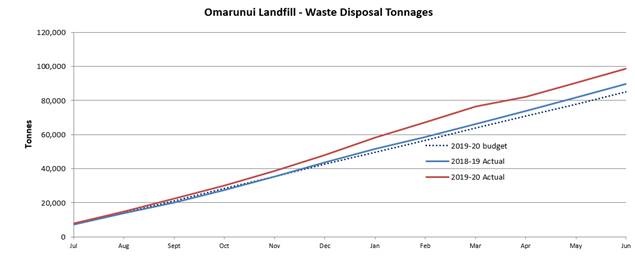

3.4 The Landfill reported a surplus of $3,693,829 for the
financial year ended 30 June 2020. This is supported by the Omarunui Landfill
Joint Committee Financial Statements for the year ended 30 June 2020 (attached
as Attachment 1). The financial statements have been audited by Audit
NZ, but formal communication of any findings have yet to be received. The
surplus of $3,693,829 was $2,378,012 above budget and is summarised as follows:
|
2018/19
Actual
|
Financial Position
|
2019/20
Actual
|
2019/20
Budget
|
2019/20
Variance
|
% Variation
|
|
9,364,287
|
Total Revenue
|
11,817,384
|
9,011,194
|
2,806,190
|
31.1%
|
|
6,874,692
|
Total Expenditure
|
8,123,555
|
7,695,377
|
428,178
|
5.6%
|
|
2,489,594
|
Surplus before adjustments
|
3,693,829
|
1,315,817
|
2,378,012
|
181%
|
3.5 The actual compared to estimated expenditure* in operations
is as follows:
|
EXPENDITURE
|
Actual $
|
Budgeted $
|
Variance $
|
Variation
|
|
|
|
Maintenance - Landfill
|
1,071,233
|
1,716,915
|
(645,681)
|
37.6%
|
|
|
Other refuse disposal
|
700,364
|
453,372
|
246,992
|
-54.5%
|
|
|
External plant hire
|
642,648
|
570,000
|
72,648
|
-12.7%
|
|
|
External plant hire escalations
|
70,177
|
40,000
|
30,177
|
-75.4%
|
|
|
Leachate Treatment/Disposal
|
93,811
|
84,000
|
9,811
|
-11.7%
|
|
|
Kiosk Charges
|
23,238
|
90,429
|
(67,191)
|
74.3%
|
|
|
Ground & Surface Water
Testing
|
18,996
|
42,080
|
(23,084)
|
54.9%
|
|
|
Gas to Energy
|
0
|
1,000
|
(1,000)
|
100%
|
|
|
Farm operations
|
2,143
|
3,683
|
(1,539)
|
41.8%
|
|
|
Rates
|
17,343
|
23,400
|
(6,057)
|
25.9%
|
|
|
Overheads - Administrative
|
15,664
|
22,999
|
(7,335)
|
31.9%
|
|
|
Depreciation
|
1,409,998
|
1,527,500
|
(117,502)
|
7.7%
|
|
|
Total
|
4,065,615
|
4,575,377
|
(509,762)
|
11.1%
|
|
*Excludes revaluation, waste levy and ETS
4.0 Maintenance
Actual maintenance costs were almost
identical to the previous 2018/19 year. However, due to changes to the
plant ledger (which has been removed) and the re-allocation of costs between
“maintenance” and “refuse disposal” budgets, an anomaly
has resulted i.e. the maintenance budget is too high and the refuse disposal
budget too low. This will be rectified in future budgets. A more accurate
view of financial performance can be gained by adding the maintenance and
refuse disposal activities together. That being said, less unplanned
maintenance work was required during the year which helped with the 37.6% under
budget result. The landfill carries out scheduled (cyclic) maintenance work
as well as unplanned work when required. Scheduled items include work on
the drains, roads, stormwater ponds, mowing, fences, landfill cap, weighbridge
and building maintenance. As a result the landfill is in very good shape.
5.0 Refuse Disposal
Refuse disposal costs
were actually slightly less than the previous 2018/19 year’s result
despite the reported overspend in the above table. As explained in the
point above (4. Maintenance), changes to the plant ledger (which has been
removed) and the re-allocation of costs between “maintenance” and
“refuse disposal” budgets, an anomaly has resulted i.e. the refuse
disposal budget is too low and the maintenance budget is too high. A more
accurate view of financial performance can be gained by adding the maintenance
and refuse disposal activities together. The net result being a below
budget result. However, disposal costs (as
shown above) are 54.5% above budget due to the anomaly. The $700,364
actual cost was a good result as it was $30,000 less than the previous year
despite the larger than anticipated volume of waste entering the site.
6.0 External Plant Hire
There was a slight
over spend on external plant hire as additional plant and plant hours were
required to deal with the greater than expected volume of refuse received at
the site.
7.0 Leachate Treatment
Leachate
treatment/disposal costs were over budget by $9,811. This was due to the
maintenance and improvement work carried out on the leachate management
system. This work has resulted in efficiency and capacity improvements to
the network.
8.0 Ground & Surface Water Testing
All ground and
surface water testing was carried out as required by the resource consents for
the site. The work is independently undertaken by Stantec (formerly MWH
consultants). This account was under spent as no additional (unscheduled)
testing was required during the course of year.
9.0 REVENUE
Total revenue was 31% more than estimated due to the
increased volumes of waste received at the site. Revenue* details are as
follows:
|
REVENUE
|
Actual $
|
Budgeted $
|
Variance $
|
Variation
|
|
|
|
Commercial Operations
|
5,430,135
|
3,781,000
|
1,649,135
|
43.6%
|
|
|
Hastings District
|
940,364
|
816,000
|
124,364
|
15.2%
|
|
|
Napier City
|
1,132,813
|
1,088,000
|
44,813
|
4.1%
|
|
|
Other Revenue (sale of gas)
|
44,907
|
45,172
|
(265)
|
-0.6%
|
|
|
Rentals (Farm)
|
9,177
|
9,402
|
(226)
|
2.4%
|
|
|
Leachate & Tyre development
|
196,356
|
160,000
|
37,436
|
23.4%
|
|
|
Total
|
7,753,752
|
5,899,574
|
1,854,178
|
31.4%
|
|
*Excludes waste levy, ETS and interest on funds
10.0 Current Development and Development
Expenditure
The
development costs for the Omarunui Landfill for the 2019/2020 year were as
follows:
|
Actual $
|
Budget $
|
Variance $
|
Variation %
|
|
$1,985,370
|
$6,730,468
|
$4,745,098
|
70%
|
Development costs
incurred during the 2019/20 year principally related to the completion of
construction work on a section of earth liner work in Area D. Other
development work included the extension of the gas capture network and
improvements to the leachate treatment system (including leachate ponds).
Overall the development budget was well under spent as a result of rescheduling
the Area D liner extension (northern end) and not starting Area B
construction. Resource consents are still required (subject to approval)
for developing Area B, and as a result only limited expenditure relating to
professional services has occurred. This expenditure mainly related to
planning, resource consent application and design activities. Development
funds not spent were carried forward to the current year.
The Area B budgets in
the landfill’s long term plan do not quite align with actual work on site
due to the extended life of Area D. That extension related to an
amendment to the Area A & D resource consent which was granted in the
previous financial year.
11.0 Future Development Work
It is expected that
further work will be carried out on developing the gas capture system in the
2020/21 year in conjunction with the new owners (LMS Energy) of the gas to
energy plant at the landfill. This work involves improving the efficiency
of the capture system so that greater control of gas quality, pressure and
quantity can be obtained. This will help the overall operation of the
flare and gas to energy plant.
Construction work is
planned for Area B in the 2020/21 year should resource consent be
granted. Planning and design work will continue in support of the consent
application (lodged in December 2019) and approval process. Tonkin &
Taylor and Stantec consultants have assisted landfill staff with this work.
To ensure continuity of available landfill airspace Area B will need to be open
for refuse disposal by late 2025.
12.0 Plant Management Contract
The current plant
management contract was scheduled to finish earlier in the year, however due to
the Covid-19 interruption to the landfill’s work programming it was
initially extended to 30th September. This date now needs to
be extended to May/June 2021. The extension is required because
the summer months are crucial for the construction of earth liner systems and a
possible change in contractor would be disruptive and potentially have a
negative impact on this construction work which needs to be completed.
An update on the tender process will
be presented at the next Committee meeting scheduled for 4th
December and a recommendation to award a new contract will be put to the
Committee at the first scheduled meeting in the new calendar year (exact date
to be confirmed but likely to be around late March). Extending the
contract to at least 31st May 2021 will allow current landfill
projects to be completed and time for the tender process to be executed in a
way works positively for the landfill and contractor alike. The lighter
work load envisaged for the later part of the financial year (May and June)
will allow landfill staff and any new contractor the ability to transition
workflow expectations more easily during that period.
13.0 Waste Levy
The waste levy was
collected at a rate of $10 per tonne during the 2019/20 year. The $10
rate continues to be applied in the current 2020/21 year but will increase to
$20 per tonne next financial year (starting 1st July 2021).
The NZ Government has decided to increase the levy from $10 to $60 per tonne
over the 4 years. The new increased rates that will need to be charged at
the landfill gate are as follows:
· 1st July 2020 = $10 per tonne (current rate being
charged)
· 1st July 2021 = $20 per tonne
· 1st July 2022 = $30 per tonne)
· 1st July 2023 = $50 per tonne)
· 1st July 2024 = $60 per tonne
Information regarding
the Governments decision on the increased levy charges has been passed onto
landfill customers.
14.0 Emissions Trading Scheme
(Waste)
The
Emissions Trading Scheme (ETS) has an impact on the gross charge rate for all
waste accepted by the landfill. The additional charge to cover ETS
compliance has been applied in a similar way to the waste levy and GST.
Accordingly the ETS charge is added to the base disposal rate as derived by the
Full Cost Accounting Model and set by the Omarunui Joint Refuse Landfill
Committee.
Over recent
years the Government has implemented changes to the ETS that have had a
significant impact on the landfill. These changes have resulted in
greater compliance costs and the ETS charge has now been lifted from $29 to $36
per tonne as of the 2020/21 year. Further increases beyond the current
level have been allowed for in future budgets.
The ETS is
the subject of a separate report to the committee.
15.0 Gas to Energy
The Omarunui Landfill Gas Plant which
was owned by Pioneer (60%) and the Hastings District Council (40%) was sold to
LMS Energy (Australia) on 13th March 2020. This marks LMS's
first entry into the NZ landfill gas market and includes the purchase of the
landfill gas assets at the Silverstream Landfill in the Hutt Valley.
LMS supplied the landfill with an
operational plan and had intended to send their Operations manager and 2
landfill gas engineers to Omarunui to conduct initial engine maintenance works
and evaluate the state of the gas field. Due to Covid-19 travel
restrictions, LMS has had to postpone these trips until further notice.
In the meantime LMS staff are endeavouring to remotely carry out as much of the
operational plan as possible until the travel restrictions are lifted.
This involves the utilisation of staff and contractors used by the previous
owners of the plant. It is now encouraging to see that LMS are managing
to operate the plant more efficiently than it was previously.
Moving forward, LMS have planned to
upgrade the entire gas delivery side of the plant including a much needed
upgrade of the cooling system. This should ensure that there is enough
vacuum applied to the gas field to run the generator at full load. These
works were pencilled in for mid-April but are now on hold until the current
travel restrictions have been lifted.
The landfill is also in discussions
with LMS on staff requirements at the site. The possibility of a joint
LMS/landfill full time position at the site is being considered as a way of
efficiently managing the gas field, flare and gas-to-energy plant. The
coordination of these activities is extremely important for them to run well
and by having one person responsible for that work is possibly the best way
forward. Discussions are ongoing.
The landfill has carried out remedial
work on parts of the gas capture network to improve performance.
This has included re-grading some of the pipes and work on the gas well
heads. Additional vertical gas wells are planned for the site over the
next two years. All new wells are integrated into the gas collection
network. This results in more landfill gas being captured and further
reduces the opportunity of odour escaping into the atmosphere from the
compacted rubbish. The additional landfill gas will in turn provide the
plant with more gas to process. Regular planning meetings with LMS
ensures that they also have input and knowledge of these work activities prior to
the work being undertaken.
16.0 Leachate & Tyres
The landfill has been
collecting $1 per tonne to generate a reserve to directly fund the development
of a permanent irrigation system and any costs relating to emergency offsite
disposal situations. The balance of the leachate reserve as at 30 June
2020 was $205,728. The reserve also funded the major remediation work
(lining) of the leachate pit on the top of Area A.
A tyre reserve was
started in 2017/18 and this has a balance in the reserve as at 30 June 2020 was
$175,213. The reserve is to assist in the off-site disposal of tyres and
therefore avoid the landfilling of this particular waste stream. The
waste tyres are transported from the landfill to Hawke’s Bay Tyre
Shredding which processes the tyres (shreds) into a fuel which is then exported
overseas. Over the past year the landfill has been able to significantly
reduce the tyre pile in size. The remaining tyres tend to be the larger
truck and tractor tyres which are not accepted by Hawke’s Bay Tyre
Shredding.
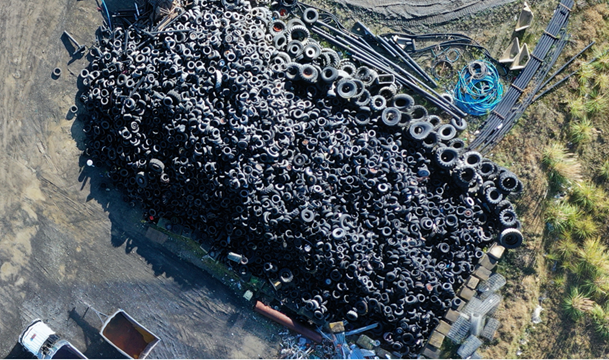
The tyre pile prior
to the 2019/20 year.
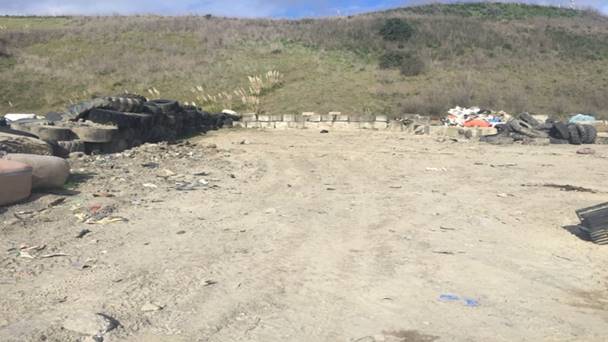
The tyre pile as of
August 2020.
17.0 Landfill Disposal Cost
The full disposal
charge rate for general waste in the 2019/20 year was $109 (ex GST) per
tonne. This included the waste levy charge of $10 and an ETS charge of
$29 per tonne. The full disposal charge rate for general waste in the
current 2020/21 year is $119 per tonne (ex GST). This includes the
waste levy charge of $10 and an ETS charge of $36 per tonne. The Ministry
for the Environment’s “Full Cost Accounting Model” is used
for calculating the base charge rate so that all costs associated with
operating the site are recovered at the gate.
18.0 Landfill Users Meeting
A landfill users
meeting was held on 17 December 2019. Topics for discussion included
charge rates, development work, general business and an update on the
implementation of the joint Waste Management & Minimisation Plan.
19.0 Opening Hours
New employment
legislation has resulted in a need to change the timing and frequency of rest
and meal breaks for staff at the landfill. The area where this change has
had the greatest impact is in the landfill kiosk. The sole kiosk operator
is required to have an unpaid half hour break during which time they cannot work.
Several options of dealing with this change were considered and the preferred
option of closing the site between 12:30pm and 1:00pm was decided to be the
best solution.
The preferred option
was initially trialled to assess the impact of the change. While the change
has not been met with universal approval from landfill customers, the vast
majority are accepting of the mid-day break and are able to plan their work day
around it.
The change also has the benefit of
allowing all landfill staff (including those at the tip face) to have a break
at the same time and therefore eliminate the need to roster staff on and off
certain activities every working day.
The effectiveness of the mid-day break
will continue to be monitored along with any problems it may cause landfill customers.
The landfill does endeavour to accommodate the needs of users where possible
and is now opening on Saturday mornings due to customer requests.
20.0 Health & Safety
20.1 The
Omarunui Landfill operates under the Hastings District Council’s Health
and Safety Policy. The Council’s commitment under this policy is “to
keep employees, volunteers, contractors and the community safe through
living a strong safety culture”.
Additional Health & Safety
information, and matters relating to the performance of the landfill over the
course of the 2019/20 year, are the subject of a separate report to this
committee.
21.0 ISO 9001 – Quality Assurance
The quality
management certification of the landfill is part of the Hastings District
Council Asset Management certification.
The Asset Management
quality system was externally audited for certification on the 11th
of February 2020 by Billy Little of Telarc SAI. The AS/NZS ISO 9001
Standard was re-certified and now has an expiry date of 20 March 2022.
22.0 Resource Consent Compliance
The Omarunui Landfill
was graded as “Fully Compliant” for all resource consents for the
period 1st June 2018 to 31st May 2019.
The landfill’s
objective is to comply with all consent requirements. Any non-compliance
issues are reported to the Hawke’s Bay Regional Council (HBRC) as per
consent instructions and dealt with accordingly if they arise.
23.0 Complaints
Typically landfill
complaints fall into two categories, that being complaints from (i) the public
i.e. neighbours, and (ii) landfill customers. The public complaints
traditionally concern odour, birds, speeding vehicles (on Omarunui Rd),
insecure truck loads and litter blown from the site. Twelve complaints
were received during the 2019/20 year.
In terms of customers
there was only one formal complaint and that concerned the condition of the
shingle road within the landfill property. As a separate matter,
information was sought from customers about the lunchtime closing and a small
amount of negative feedback was received concerning the change.
Maintenance work on
the unsealed access road is continuous and includes watering, grading and the
application of suitable metal. From time to time verbal complaints about
the condition of the unsealed access road are received from licenced waste
operators using the site. When such a complaint is received the condition
of the road is re-evaluated and maintenance work is carried out as required.
There were twelve
public complaints during the year. One of the complaints was in relation
to seagulls, one concerned the poisoning of seagulls, six concerned odour and
the remaining four were about litter/insecure loads.
In response to the
bird complaints, additional scaring and culling was carried out by way of
shooting by a registered pest control officer. The four litter complaints
were dealt with promptly by immediately cleaning up litter and contacting the
operator of any vehicle proven to have an insecure load.
In general terms of
litter, the landfill’s policy is to pick up litter whenever required
(without prompting) and from neighbouring properties following any strong winds
or insure load incident. This proactive approach has worked well and
results in fewer complaints from neighbours of the landfill.
All odour complaints
are investigated by landfill staff to determine the origin. As not all
odours in this rural location can be attributed to the landfill, wind direction
information is monitored at the site so that the source of any odour can be
more easily tracked and identified. Odours that may emit from time to
time are typically caused by a smelly load of waste entering the site or when
existing waste is excavated during development work (i.e. installing gas
wells). The new gas extraction wells that have been installed in Area D
have created a negative pressure zone which has reduced the tendency for
landfill gas to vent out into the open air.
Odour complaints are also investigated
by the Hawke’s Bay Regional Council and if they have not been contacted
by the complainant the landfill will do that on the complainant’s behalf.
Of the six odour complaints received,
four where from the same address on Swamp Road which has new owners. The
landfill has no previous record of complaint from this property and there is a
property closer to the landfill (in a relatively direct line) which did not
complained about odour. No obvious cause was determined on these
occasions and the complaints remain unresolved.
24.0 Covid-19
The Covid-19 lock
down presented the landfill with a number of issues, these mainly involved the
safety and wellbeing of landfill staff, contractors and customers. The
landfill is an essential service and was required to operate as normal
throughout the entire time. The acceptance of some special waste (i.e.
asbestos) was put on hold, however the demand for special waste disposal
dropped significantly over the Covid-19 period due to it not been related to
essential work.
Landfill staff
handled the situation well and worked in conjunction with HDC Health &
Safety officers to ensure that safe and compliant work practices were being
followed. These measures also applied to landfill customers, contractors
and anyone accessing the site. For a period of time a split shift was
operated by landfill staff to reduce the amount of interaction between
workers. Staff members deemed vulnerable stayed at home during Levels 4
and 3. Landfill staff should be commended for their efforts and keeping
the site operating during this difficult time
One very noticeable
impact of the Covid-19 lockdown was drop in refuse entering the site during
April. The average per month tonnage for the 2019/20 year was around the
8,500 tonne mark, however only 5,500 tonnes was received in April. The brief
drop in waste had no real impact on the landfill accounts as tonnages were
tracking well above estimate and continued to do so after April.
The drop in tonnages
during the level 4 part of the Covid-19 lockdown related to the component of
waste that was produced from nonessential work activity i.e. construction and
non-exempt business activity.
25.0 Concluding Comments
After a period of
static tonnages, landfill waste has been on the increase from 2015
onwards. Since that time the amount of waste being deposited at the site
has increased from 72,000 tonnes to 98,700 tonnes per annum. This
represents an average increase of approximately 5,340 tonnes per year over that
period. This increase is seen as a reflection of economic and population
growth in Hawke’s Bay over the last five to six years.
The landfill can be
extremely proud of its “fully compliant” status with regards
resource consent compliance and its continued efforts to operate efficiently
and safely.
As highlighted in
this report the landfill worked through the Covid-19 lockdown and remained open
to receive all essential service waste. The landfill managed this safely
and efficiently without incident.
The next few years
are going to be challenging ones for the landfill as major plant items are due
for replacement (i.e. compactor and loader), a new plant management contract
needs to be awarded, the completion of Area D development and new resource
consents are required to permit landfilling to continue at the site (Area
B). Once a new consent is granted, construction work will need to
commence immediately to ensure that the landfill can remain operational and
continue to receive waste.
Along with other
Waste Management & Minimisation Plan (WMMP) initiatives, changes to urban
kerbside recycling and refuse and collection services will have an impact on
the landfill. As participation rates improve for recycling and more green
waste is diverted away from the landfill for composting, the composition and
quantity of waste is likely to change. The landfill will continue to
monitor the situation and adapt its business and environmental approach to
maximise its overall performance and benefit to the region.
Attachments:
|
1⇩
|
Omarunui Landfill Annual Report 30th June 2020
|
CG-14-147
|
|
|
Summary of
Considerations - He Whakarāpopoto Whakaarohanga
|
|
Fit
with purpose of Local Government - E noho hāngai pū ai ki te
Rangatōpū-ā-Rohe
The Council is required to give effect to the purpose of
local government as set out in section 10 of the Local Government Act 2002.
That purpose is to enable democratic local decision-making and action by (and
on behalf of) communities, and to promote the social, economic,
environmental, and cultural wellbeing of communities in the present and for
the future.
Link to the Council’s
Community Outcomes –
Ngā Hononga ki Ngā Putanga ā-Hapori
This proposal promotes the <Enter
text> wellbeing of communities in the present and for the future.
|
|
Māori
Impact Statement -
Te Tauākī Kaupapa Māori
<Enter text> :
|
|
Sustainability
- Te
Toitūtanga
<Enter text> :
|
|
Financial
considerations -
Ngā Whakaarohanga Ahumoni
<Enter text> :
|
|
Significance
and Engagement -
Te Hiranga me te Tūhonotanga
This decision/report has been assessed under the Council's
Significance and Engagement Policy as being of <Enter
text> significance.
|
|
Consultation
– internal and/or external - Whakawhiti Whakaaro-ā-roto / ā-waho
<Enter text> :
|
|
Risks
Opportunity:<Enter text> :
|
REWARD – Te Utu
|
RISK – Te Tūraru
|
|
[State the benefit, opportunity, innovation of the
outcome & whether it benefits; Safety (public/ staff/ contractors),
Finances, Service Delivery, Legal compliance, Reputation.]
|
[State the significant risks or threats (4 or 5 max) to
the objective & whether they affect; Safety (public/ staff/
contractors), Finances, Service Delivery, Legal compliance, Reputation.]
|
|
|
Rural
Community Board –
Te Poari Tuawhenua-ā-Hapori
<Enter text> :
|
|
Omarunui
Landfill Annual Report 30th June 2020
|
Attachment 1
|
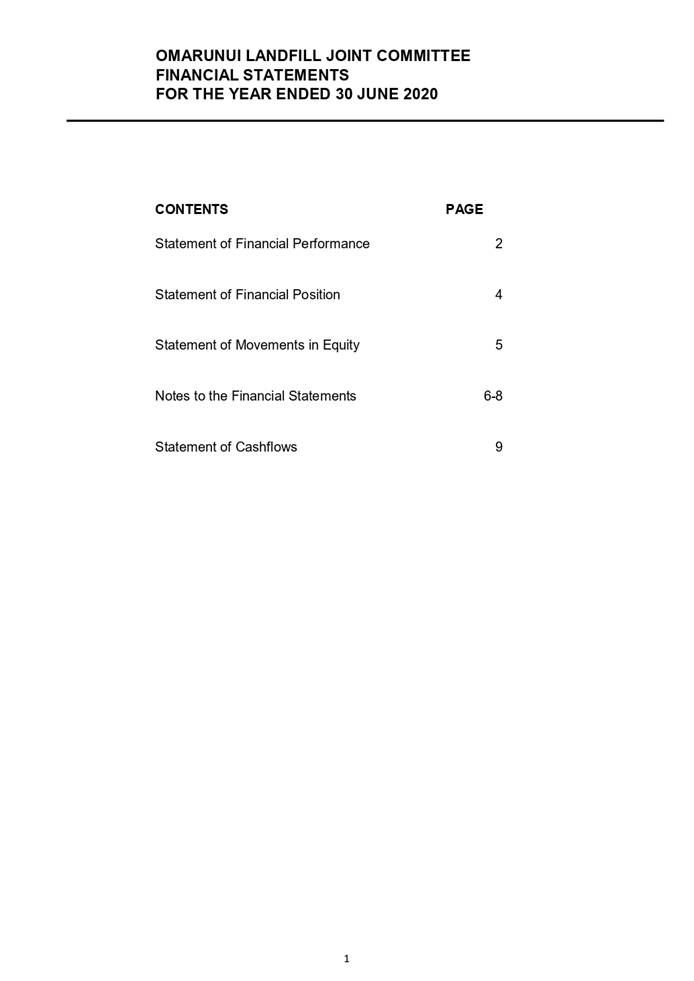
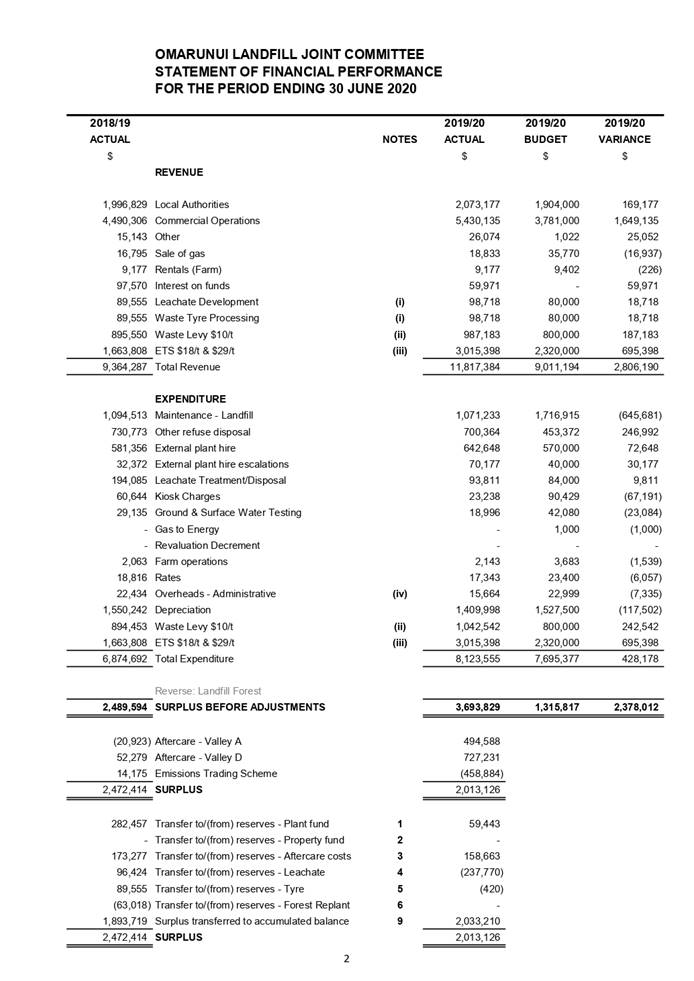
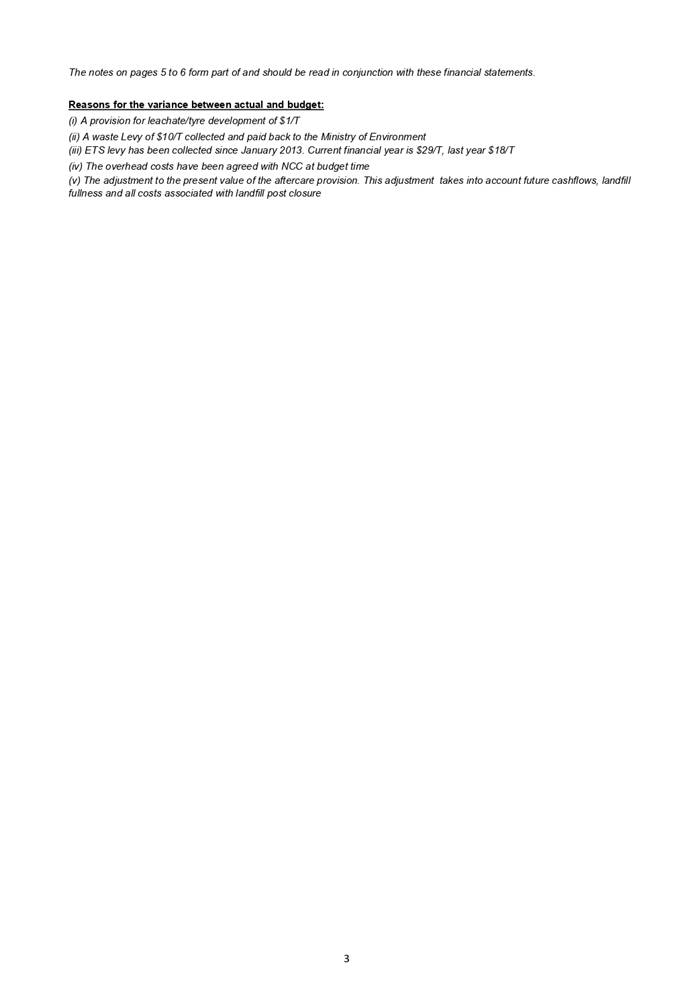
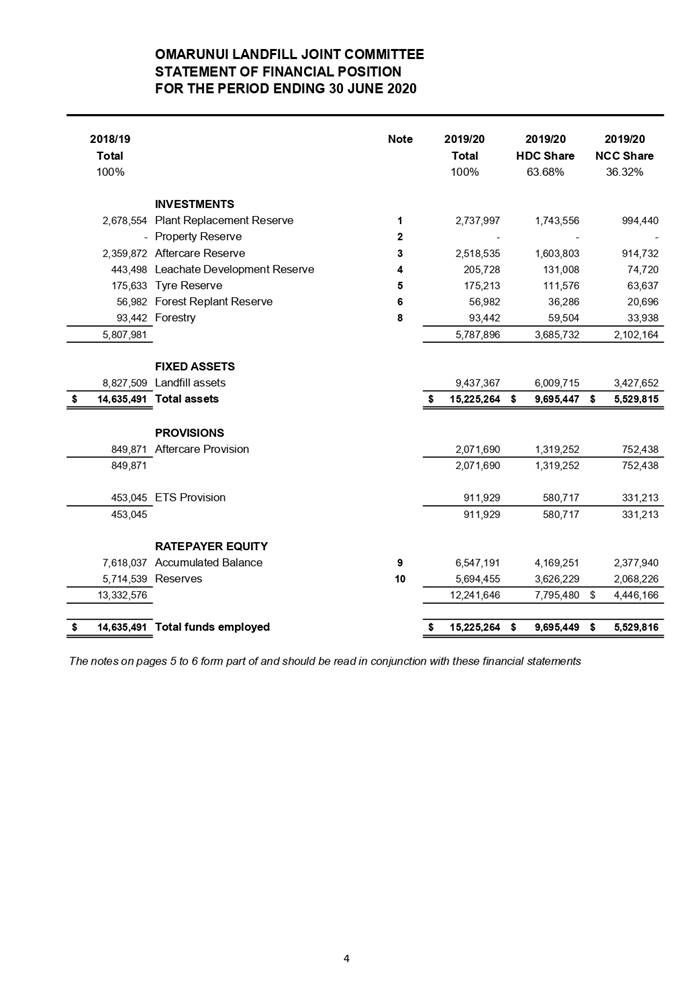
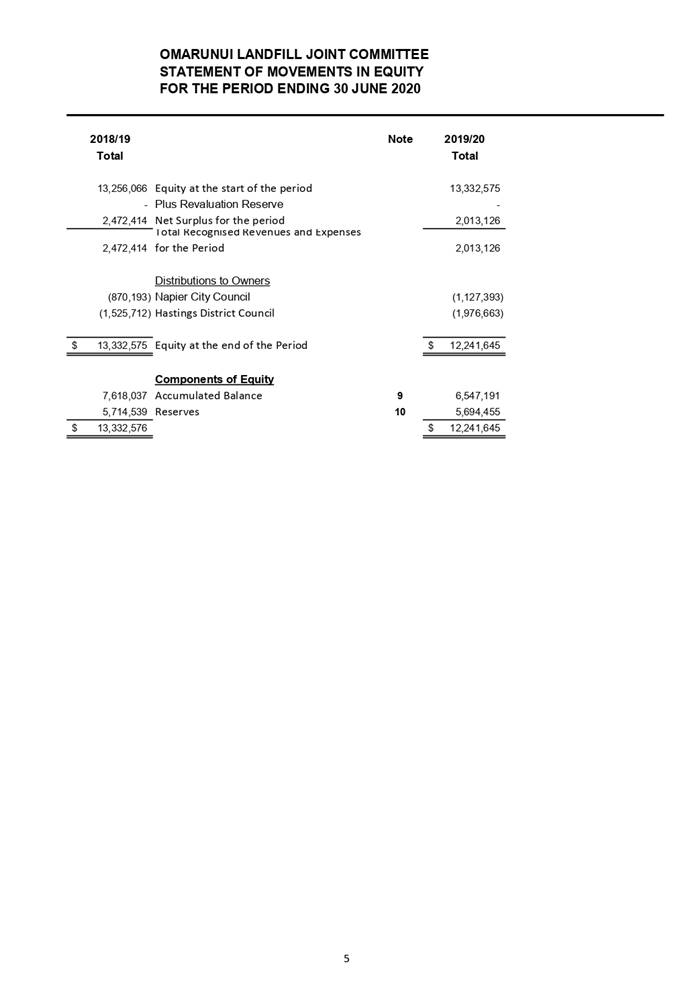
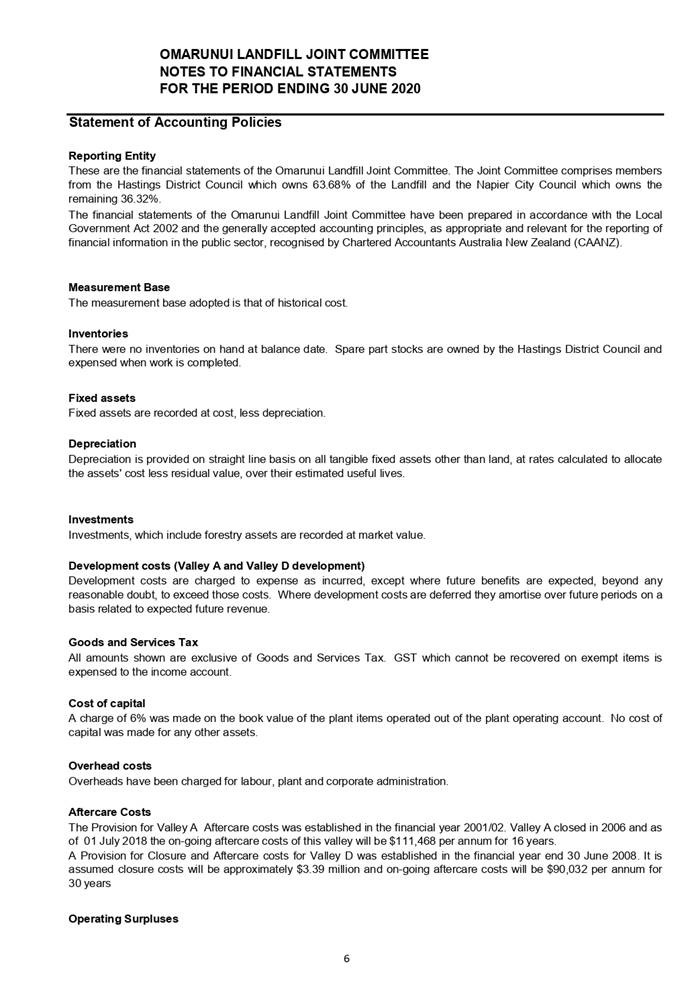


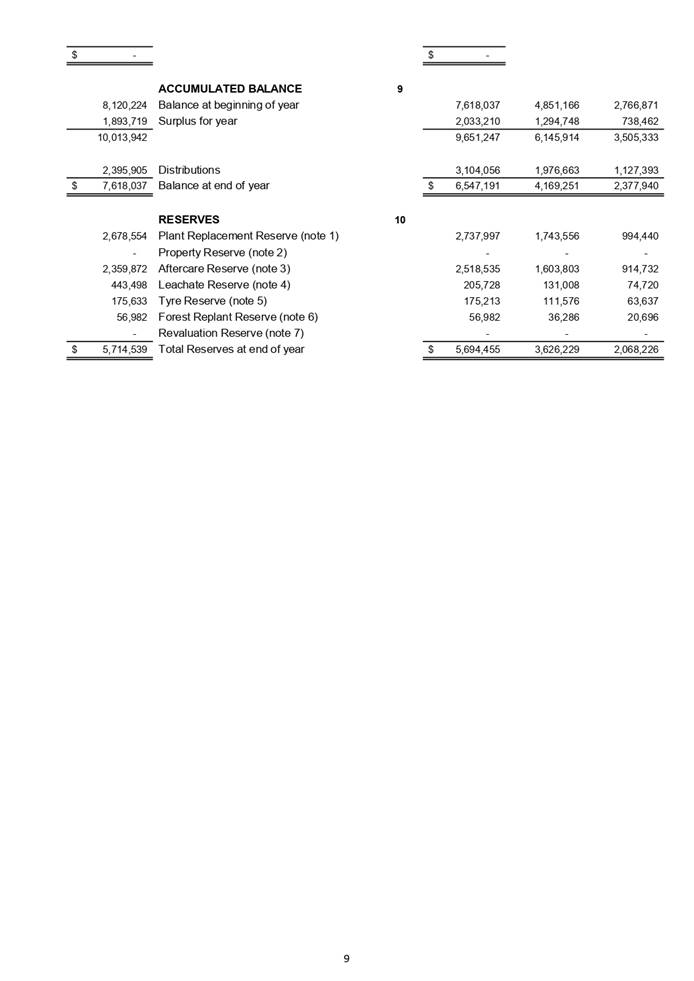
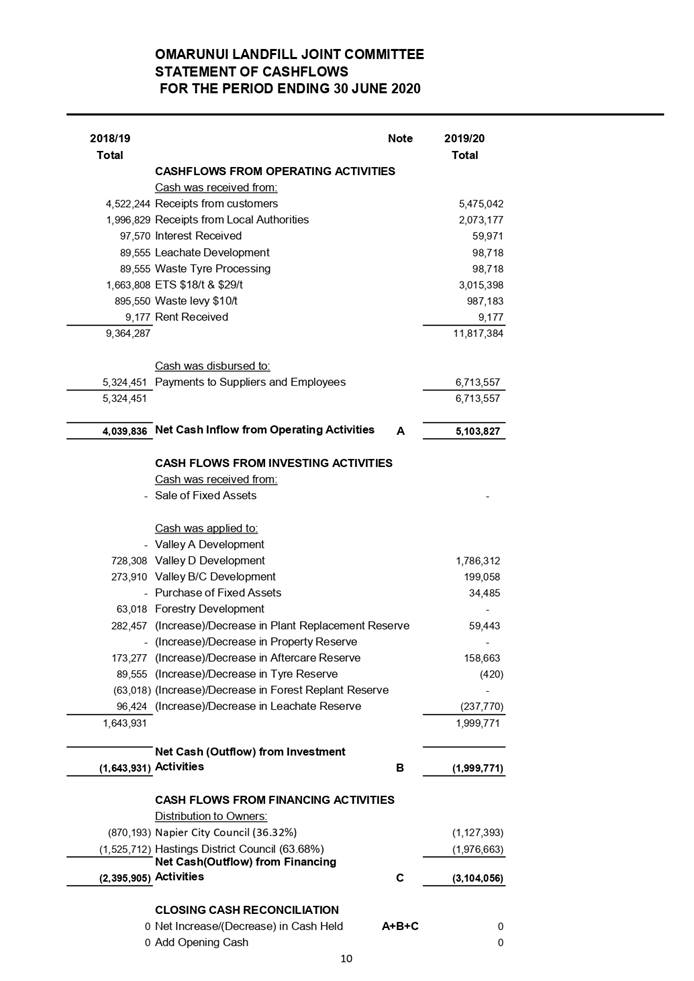

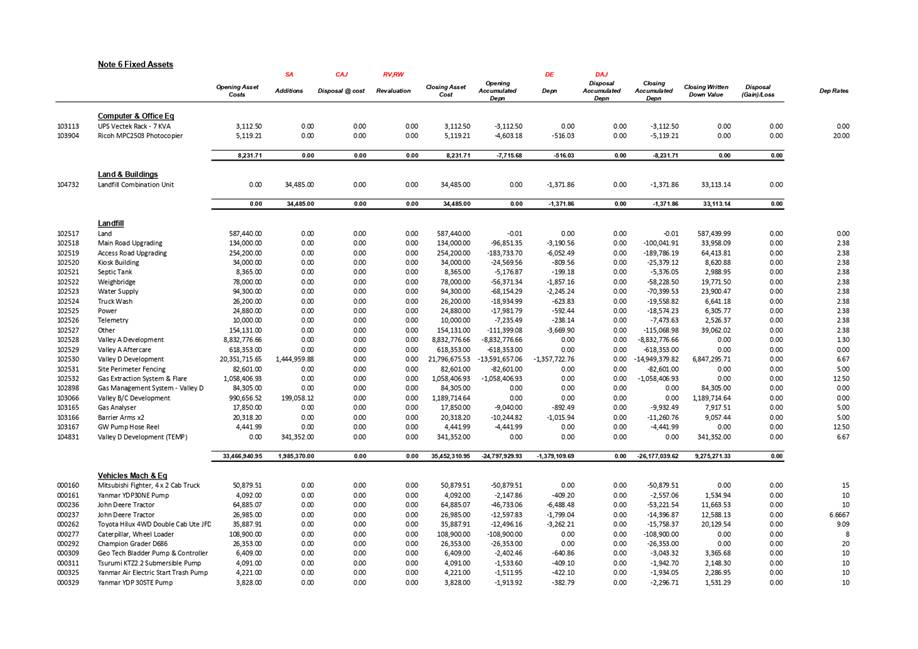
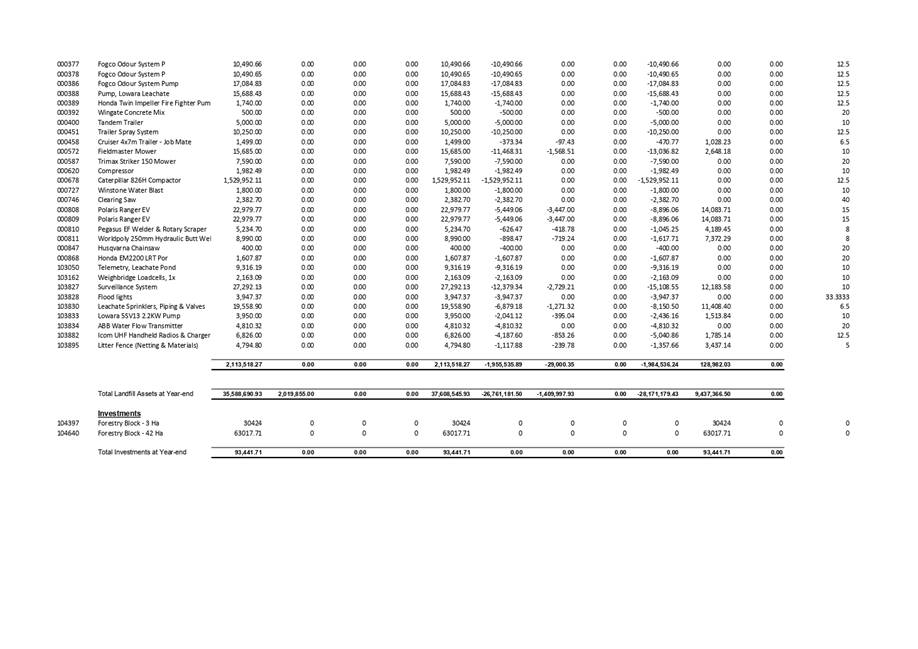
Hastings
District Council: Omarunui Refuse Landfill Joint Committee Meeting
Te Rārangi Take
Report to Omarunui Refuse Landfill Joint Committee
|
Nā:
From:
|
Jeff Tieman, Management
Accountant
|
|
Te Take:
Subject:
|
Annual Review of Hedging
Strategy for Landfill Carbon Emissions
|
1.0 Executive Summary
– Te Kaupapa Me Te
Whakarāpopototanga
1.1 The
purpose of this report is to obtain a decision from the Committee on the
hedging strategy for carbon emissions at the Omarunui Landfill.
1.2 This
issue arises from the regulations for landfill methane emissions under the New
Zealand Emissions Trading Scheme (NZ ETS) which require waste disposal facility
operators to surrender emissions units (known as New Zealand Units, NZU) by 31
May each year to match their emissions for the previous calendar year.
|
2.0 Recommendations – Ngā Tūtohunga
A) That the Omarunui
Refuse Landfill Joint Committee receives the report titled Annual Review of
Hedging Strategy for Landfill Carbon Emissions.
B) That
the Committee endorse the forward purchase contact for 157,820 New Zealand
units currently estimated at around $6,061,715 to fix the price of NZUs for
the calendar years 2021, 2022, 2023 and 2024, in line with adopted
policy. The Chief Executive (Hastings District Council) be authorised
to approve the nature of the contract and to execute the necessary contracts.
C) That it be
noted that the actual cost of the extension of the forward purchase contract
can only be firmly established when the order is placed in the market.
D) That
the hedging strategy be reviewed annually.
|
3.0 Background
– Te Horopaki
3.1 A
report on the surrender requirements and obligations for Landfills under the
Emissions Trading Scheme (ETS) was presented to the Omarunui Refuse Landfill
Joint Committee at a meeting on 29 June 2012. In summary the report recommended
the parent Councils approve the purchase of NZU forward contracts to fix the
price of NZUs for three years in advance. This would ensure prudent management
of NZU price risk, provide the Landfill with price certainty on NZU prices and
ensure full cost recovery.
3.2 At
its meeting on the 5th October 2018, the Omarunui Refuse Landfill
Joint Committee approved a hedging strategy to hold forward contracts for
NZU’s at 100% for the next 3 years, 80% for year 4 and 60% for year 5.
3.3 The
committee also resolved that the hedging strategy be reviewed annually.
3.4 The
landfill has met its surrender obligations for the 2019 calendar year. The
landfill had forward cover contracts for 105,910 NZU. Officers elected to
retain 11,900 units from this contract to utilise for the 2020 year and settled
the shortfall with the fixed rate payment option of $25 per unit, which was the
last year this price was available. This allowed the landfill to have
sufficient units available for the 2020 calendar year as we estimate we will
have around 100,000 tonnes for the year, with contracted units to cover 90,000
tonnes. This will save the landfill approximately $119,000. The continuous growth
in tonnes has meant officers have revised their position on future volumes from
90,000 tonnes to 100,000 tonnes and this is reflected in the proposed future
contract volumes. The landfill currently holds the following forward contracts:
|
Calendar year
|
Surrender
|
Cover
|
Seller
|
Buyer
|
No of NZU's
|
Price/unit
|
Cost
|
|
2020
|
May 2021
|
100%
|
Westpac
|
HDC
|
107,100
|
$27.65
|
$2,961,315
|
|
2021
|
May 2022
|
80%
|
Westpac
|
HDC
|
85,680
|
$28.71
|
$2,459,872
|
|
2022
|
May 2023
|
60%
|
Westpac
|
HDC
|
64,260
|
$29.80
|
$1,914,948
|
As
well as this, the landfill also has authority (September 2019 Omarunui Refuse
Landfill Joint Committee meeting recommendation) to purchase 107,100 units
which officers have been unable to purchase due to technical issues with
Westpac Bank’s ability to participate in the NZU market. Westpac have
advised that this issue should be resolved in the next few months.
|
Calendar year
|
Surrender
|
Cover
|
Seller
|
Buyer
|
No of NZU's
|
Price/unit
|
Cost
|
|
2021
|
May 2022
|
20%
|
Westpac
|
HDC
|
21420
|
$ 26.75
|
$
572,985.00
|
|
2022
|
May 2023
|
20%
|
Westpac
|
HDC
|
21420
|
$ 27.65
|
$
592,263.00
|
|
2023
|
May 2024
|
60%
|
Westpac
|
HDC
|
64260
|
$ 28.55
|
$ 1,834,623.00
|
4.0 Discussion – Te Matapakitanga
4.1 The
chart below shows the trend in the NZU spot price for the last 2 years, plus
the latest pricing for the spot and future units.
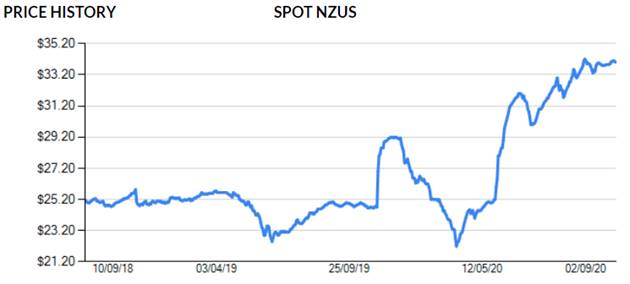
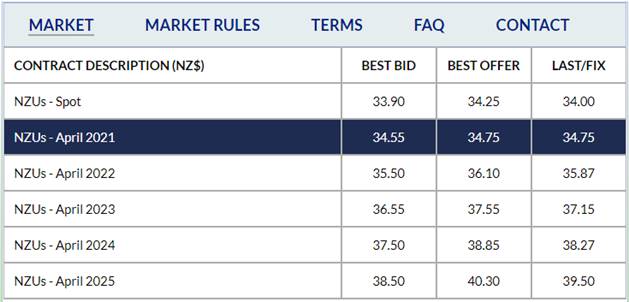
4.2 In
2019 the Government reviewed how the whole emission trading scheme operated in
New Zealand. The result of this has seen the fixed price option of $25 per unit
removed and replaced with a temporary $35 per unit. This will remain in place
until an auction system is set up where the unit price will have a floor value
(first year of $20) and a ceil price (first year of $50). The ceiling price
will be managed with a cost containment reserve, which will see the Government
releasing units into the market when the price reaches the $50 per unit price
in the first year. Once the auction system has been implemented, the fixed
price option will be removed. Attached is a summary from the Ministry of the
Environment with full details of the new scheme.
4.3 Current
indicative NZU forward cover price for 2022 is 35.87, 2023 $37.15, 2024 $38.27
and 2025 $39.50.
4.4 Based
on latest forecast and economic growth for the region, the expected tonnage for
2021 and beyond has been revised to 100,000 tonnes.
4.5 Based
on the expected tonnage of 100,000T the following table summarises the volume
and estimated price this will cost the landfill.
|
Calendar
Year
|
Surrender
|
Seller
|
No of
NZU’s to purchase
|
Total
accumulation
|
Price/Unit
|
Cost
|
|
2021
|
May 2022
|
Westpac
|
11,900
|
119,000
|
$35.87
|
$426,853
|
|
2022
|
May 2023
|
Westpac
|
33,320
|
119,000
|
$37.15
|
$1,237,838
|
|
2023
|
May 2024
|
Westpac
|
41,200
|
95,200
|
$38.27
|
$1,576,724
|
|
2024
|
May 2025
|
Westpac
|
71,400
|
71,400
|
$39.50
|
$2,820,300
|
|
|
|
|
157,820
|
|
|
$6,061,715
|
5.0 Options – Ngā Kōwhiringa
Option One - Recommended Option -
Te Kōwhiringa Tuatahi – Te Kōwhiringa Tūtohunga
5.1 To take out forward
cover contracts as summarised in 4.5 at a total estimated cost to the landfill
of $6,061,715. This will provide certainty on price to allow the officers to
set gate prices to give advanced warning to the community and commercial
operators that utilise the landfill facilities.
Advantages
· Provide
certainty with setting the annual gate price
Disadvantages
· None
Option Two – Status Quo - Te
Kōwhiringa Tuarua – Te Āhuatanga o nāianei
5.2 Take
no forward cover contracts for 2021, 2022, 2023 and 2024 calendar years and
purchase on the spot market at time of settlement. This will cause uncertainty
on price at time of setting the gate price and could create a situation where
the landfill either under or over recovers the ETS charge
at the gate.
6.0 Next
steps – Te
Anga Whakamua
6.1 If
the Landfill Committee approve option one, officers will engage Westpac to go
to the market and secure the required NZU’s for each of the calendar
years. Once we have the contracts from Westpac, these will be presented to the
Chief Executive for execution.
7.0 Summary
of Considerations - He
Whakarāpopoto Whaiwhakaaro
Fit with purpose of Local Government -
E noho hāngai pū ai ki te Rangatōpū-ā-rohe
7.1 The
Council is required to give effect to the purpose of local government as set out
in section 10 of the Local Government Act 2002. That purpose is to enable
democratic local decision-making and action by (and on behalf of) communities,
and to promote the social, economic, environmental, and cultural well-being of
communities in the present and for the future.
Attachments:
|
1⇩
|
Omarunui Refuse Landfill Emission Trading Scheme update
4/9/2020
|
CG-14-27-00070
|
|
|
Summary of
Considerations - He Whakarāpopoto Whakaarohanga
|
|
Fit
with purpose of Local Government - E noho hāngai pū ai ki te Rangatōpū-ā-Rohe
The Council is required to give effect to the purpose of
local government as set out in section 10 of the Local Government Act 2002.
That purpose is to enable democratic local decision-making and action by (and
on behalf of) communities, and to promote the social, economic,
environmental, and cultural wellbeing of communities in the present and for
the future.
Link to the Council’s
Community Outcomes – Ngā Hononga ki Ngā Putanga ā-Hapori
This proposal provides certainty in
setting gate prices at the landfill which allows the transfer stations and
commercial operators to set their prices for the community.
|
|
Māori
Impact Statement -
Te Tauākī Kaupapa Māori
No implications
|
|
Sustainability
- Te
Toitūtanga
This meets our legal obligation under the
emission trading scheme to settle 1.19 NZU per tonne of waste that is taken
to the landfill.
|
|
Financial
considerations -
Ngā Whakaarohanga Ahumoni
By locking in a fix price for
purchase of NZU for a calendar year provides security in setting the gate
price and that the users of the landfill are fully charged for the purchase
of NZU to cover the landfill requirements under the ETS.
|
|
Significance
and Engagement - Te
Hiranga me te Tūhonotanga
This report has been assessed under the Council's
Significance and Engagement Policy as being of minor significance.
|
|
Consultation
– internal and/or external - Whakawhiti Whakaaro-ā-roto / ā-waho
Not applicable
|
|
Risks
Opportunity:
No implications
|
REWARD – Te Utu
|
RISK – Te Tūraru
|
|
[State the benefit, opportunity, innovation of the
outcome & whether it benefits; Safety (public/ staff/ contractors),
Finances, Service Delivery, Legal compliance, Reputation.]
|
[State the significant risks or threats (4 or 5 max) to
the objective & whether they affect; Safety (public/ staff/ contractors),
Finances, Service Delivery, Legal compliance, Reputation.]
|
|
|
Rural
Community Board –
Te Poari Tuawhenua-ā-Hapori
No Implications
|
|
Omarunui
Refuse Landfill Emission Trading Scheme update 4/9/2020
|
Attachment 1
|
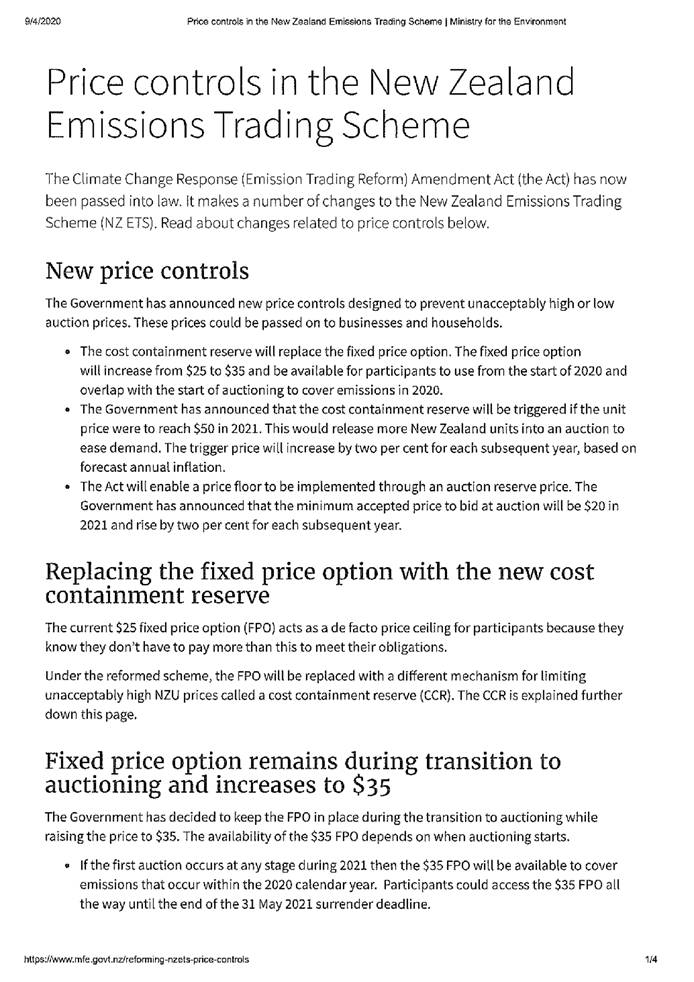
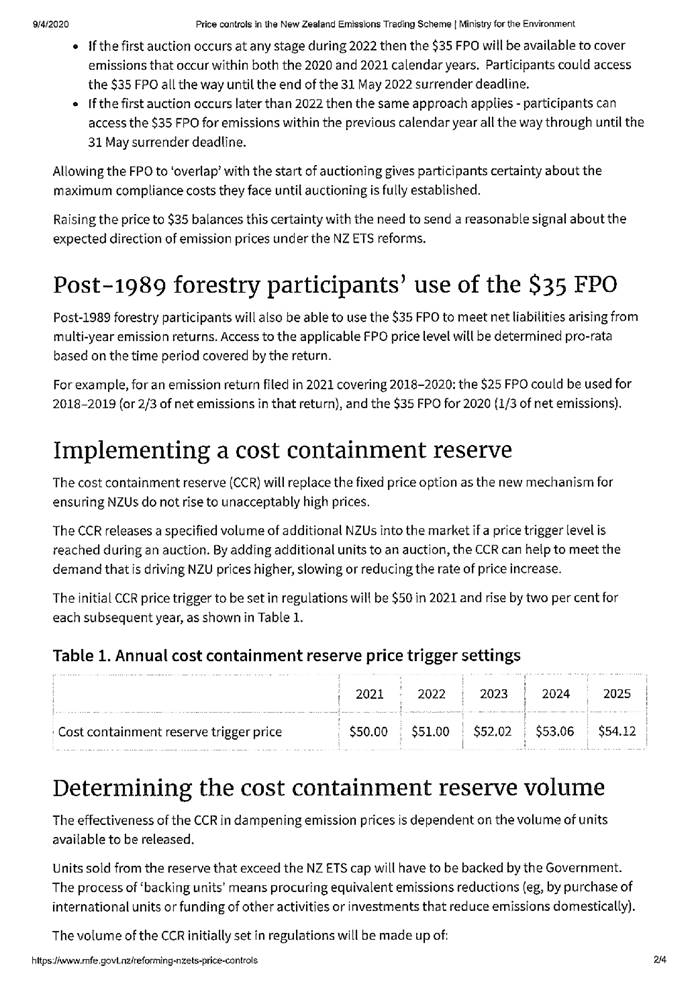
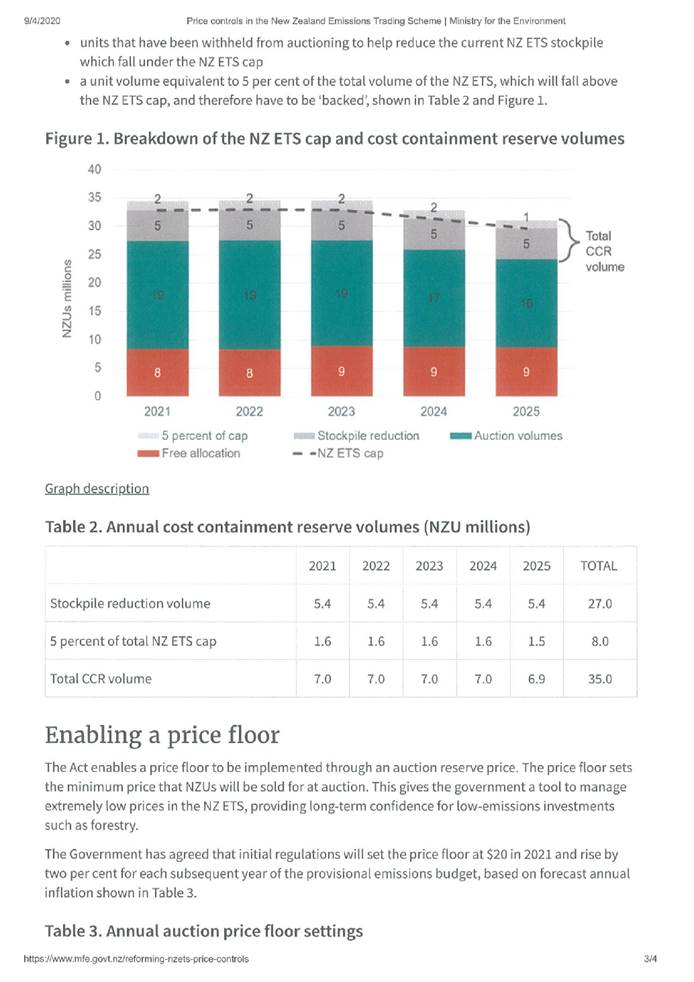
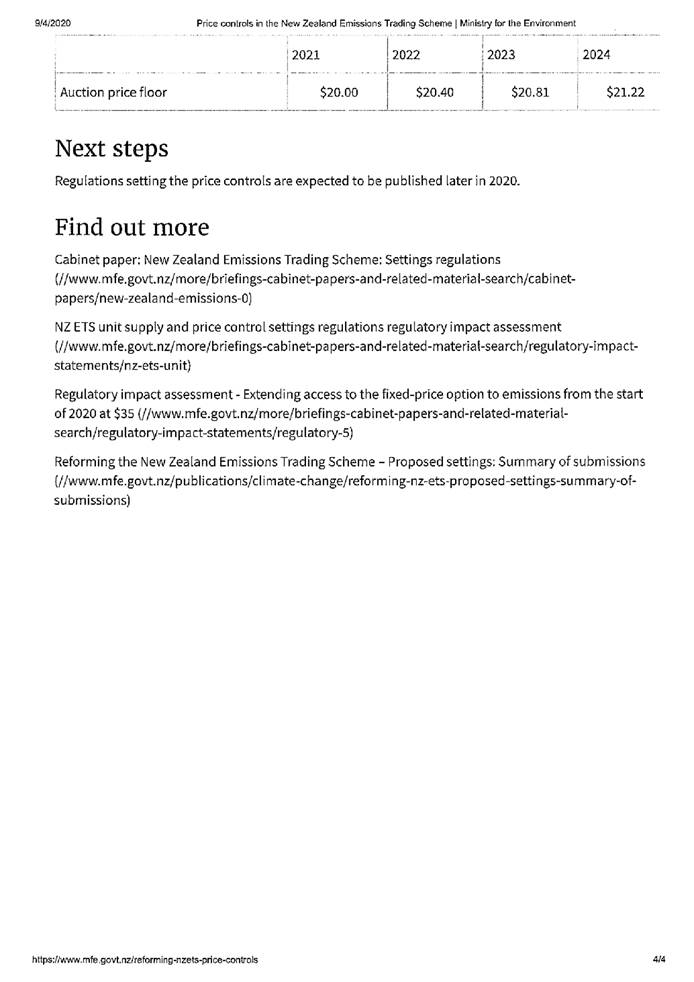
|
Friday, 25 September 2020
|
 Te Hui o Te Kaunihera ā-Rohe o Heretaunga
Te Hui o Te Kaunihera ā-Rohe o Heretaunga
Hastings
District Council: Omarunui Refuse Landfill Joint Committee Meeting
Te Rārangi
Take
Report to Omarunui Refuse Landfill Joint Committee
|
Nā:
From:
|
Angela Atkins, Waste
Planning Manager
|
|
Te Take:
Subject:
|
Discussion Document
regarding the possible introduction of material-specific pricing at Omarunui
Landfill
|
1.0 Executive Summary – Te Kaupapa Me Te
Whakarāpopototanga
1.1 The
purpose of this report is to seek support from the committee for officers to
undertake further work investigating the establishment and implementation of
material specific pricing for problematic waste materials at Omarunui Landfill.
1.2 This
issue arises from Action 8A of Joint Waste Management and Minimisation Plan
2018 to 2024 (JWMMP) which sets out both Hastings District and Napier City
Councils’ responsibility to Investigate the introduction of
material-specific pricing at Omarunui Landfill.
1.3 This
report also aligns with the JWMMP vision - To deliver waste minimisation and
resource recovery across Hastings District and Napier City working towards zero
waste.
|
2.0 Recommendations – Ngā Tūtohunga
A) That
the Omarunui Refuse Landfill Joint Committee receives the report titled
Discussion Document regarding the possible introduction of material-specific
pricing at Omarunui Landfill.
B) That
the Committee approve staff undertaking further work to investigate the
possibility of establishing material specific pricing at Omarunui Landfill.
|
3.0 Background – Te Horopaki
3.1 The
JWMMP sets out a number of objectives and actions to reduce waste to landfill
with the following relating directly to the opportunity to introduce material
specific pricing;
3.1.1 Goal
One of the JWMMP is Reduce, Recover and Recycle more waste in order to
contribute to the New Zealand Waste Strategy goal: “Reducing the harmful
effects of waste”.
Objective
1: To reduce total amount of waste to landfill per person in Napier and
Hastings, particularly with regard to organic waste e.g. green waste and food
waste.
Objective
2: To increase recovery (identification and removal of items) destined for
landfill that can be reused, recovered or recycled.
3.1.2 Goal
Three of the JWMMP is Improve community awareness on waste and recovery trends
and knowledge around resource recovery and diversion potential.
Objective
3: To work with businesses – manufacturing/industrial/retail – on
options for recovering, reusing and recycling commercial waste.
3.2 The
underlying philosophy of the JWMMP is to divert as much waste as possible from
Omarunui Landfill. The Hastings District and Napier City Councils also believe
that local businesses and industries have an opportunity and responsibility to
manage waste appropriately.
4.0 Discussion – Te Matapakitanga
4.1 There
is a specific action of the Joint Waste Management and Minimisation Plan
2018-2024 – Action 8A - Investigate the introduction of
material-specific pricing at Omarunui Landfill.
4.2 Omarunui
Landfill has experienced increasing tonnage for the past five years, after a
period of static tonnages. During this time the amount of waste being
deposited at the site has increased from 72,000 tonnes to 98,700 tonnes per
annum. This represents an average increase of approximately 5,340 tonnes
per year over that period. This increase is seen as a reflection of
economic and population growth in Hawke’s Bay over the last five to six
years. This is a 37% increase over the five year period.
4.3 Additional
to the increase in tonnage, staff onsite have noticed an increase in the volume
of packaged food waste and other divertable materials that are being disposed
of to landfill because of production methods. As a result alternative disposal
options are considered too expensive and/or too time consuming sorting to be
undertaken.
4.4 The
ultimate waste minimisation goal is for waste to only be disposed of at
landfill when there are no other physical options, regardless of cost.
Landfill needs to be conserved as a community asset for the benefit of future
generations and we don’t want to leave a bad legacy for future
generations either.
4.5 Current
charge rates for general and special waste, effective from 1 July 2020:
|
Item
|
2020/21 charge rate (excludes GST)
|
|
Municipal refuse.
A minimum charge of $214
(excludes GST) applies to municipal refuse.
|
$119.00 per tonne or
part thereof
(made up of $73 base cost, plus $10 Levy, plus $36
ETS)
|
|
Special Wastes as follows:
· Semi
liquid waste
· Offal
· Hazardous
waste
· Contaminated
waste
· Putrescible
waste
· Vehicle
parts
A minimum charge of $234 (excludes
GST) applies to the special wastes listed above.
|
$156.00 per tonne or
part thereof
|
4.6 Annual
tonnage to Omarunui Landfill by material type:
|
2019/20
|
2018/19
|
2017/18
|
2016/17
|
2015/16
|
|
Animal Disposal
|
13
|
13
|
15
|
14
|
12
|
|
Asbestos
|
3,849
|
508
|
475
|
498
|
493
|
|
Chemicals & Baits
|
2
|
2
|
3
|
2
|
3
|
|
Chrome & Tannery Waste
|
2,920
|
2,478
|
2,829
|
1,519
|
1,784
|
|
Commercial & Industrial
|
25,651
|
23,600
|
22,607
|
24,404
|
22,690
|
|
Construction & Demolition
|
1,617
|
1,036
|
773
|
1,108
|
337
|
|
Food Waste
|
3,195
|
3,371
|
4,563
|
3,737
|
2,521
|
|
Milliscreen Waste
|
514
|
506
|
488
|
450
|
416
|
|
Polystyrene
|
17
|
42
|
9
|
3
|
3
|
|
Road Sweepings &
Contaminated Soil
|
6,923
|
3,183
|
1,100
|
1,680
|
1,686
|
|
Transfer Stations
|
20,599
|
21,642
|
21,165
|
20,826
|
19,615
|
|
Tyres
|
0
|
7
|
66
|
2
|
27
|
|
Kerbside Collections
|
27,732
|
28,588
|
29,828
|
28,114
|
25,157
|
|
Offal / Meat Waste
|
3,010
|
10
|
0
|
0
|
14
|
|
Out of District
|
34
|
15
|
0
|
1
|
1
|
|
Special Waste
|
2,638
|
4,350
|
2,049
|
1,579
|
435
|
|
Vehicle Parts
|
0
|
36
|
72
|
99
|
134
|
|
Total
|
98,714
|
89387
|
86,043
|
84036
|
75,327
|
4.7 Annual
tonnage of special wastes to Omarunui Landfill
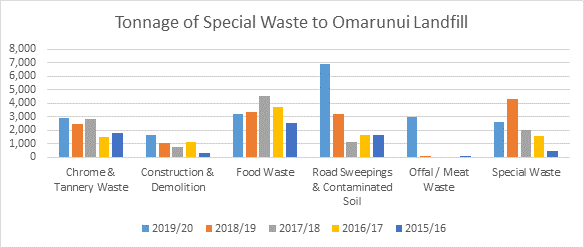
4.8 Recent
Examples of loads and materials
4.8.1 Example
of one load – July 2019 – 30m3 of frozen meat (weight 10.6
tonnes). This could have been sent to BioRich or Eco Stock Feed if it was
depackaged.
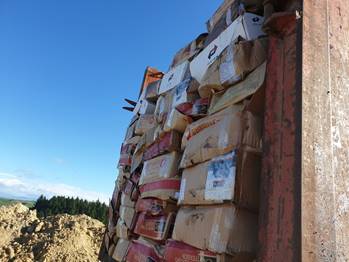

4.8.2 Example
2 – plastic sauce bottles, a mixture full and empty – August 2019
– 8.2 tonnes
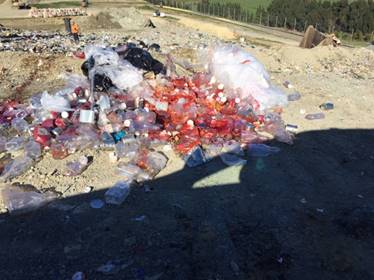
4.8.3 Example
3 – over a 15 day period 17 x 30m3 hook bins of canned product, total
weight 186.66 tonnes.
4.8.4 This
financial year we have seen an increase in offal and meat waste, particularly
pelts (700 tonnes), which normally go to Bio Rich for composting, however they
have reached their processing capacity for these types of putrescible wastes.
The HDC and NCC officers have provided a letter of support for BioRich’s
application to the National Waste Disposal Levy Contestable fund to expand
their operation and increase processing capacity.
4.9 In
addition to the organic waste materials coming to landfill, there are other
materials used in the agricultural and horticultural sectors that can be
recycled such as bird netting, polythene, however they require more work to
clean, prepare and package for recycling.
4.10 Where
an alternative sustainable reuse option exists, this should be used and
landfill pricing reviewed to reflect, i.e. the gate rate for these material
should be higher to encourage further diversion and reuse. Currently it
is cheap and easy to dump instead of looking for recovery options so few
companies look into alternative disposal options.
4.11 The
increase of the national waste disposal levy commencing 1 July 2021 from $10 to
$20 per tonne and $60 by 2024 is drive more diversion of material from landfill
and the introduction of material specific pricing at Omarunui Landfill is in
line with this concept.
5.0 Options – Ngā Kōwhiringa
Option One - Recommended Option -
Te Kōwhiringa Tuatahi – Te Kōwhiringa Tūtohunga
5.1 Officers
investigate and report back to the committee at a future committee meeting
regarding possible new gate rates for some materials:
Advantages
· Alignment
with the JWMMP
· Reducing
waste to landfill
· Conserving
space for future years.
· In
line with national policy to increase diversion of material from landfill.
Disadvantages
· A
change from the current pricing structure
· May
require additional resourcing at landfill to monitor and accurately record.
Option Two – Status Quo - Te Kōwhiringa Tuarua – Te
Āhuatanga o nāianei
5.2 Do
not investigate – leave gate rates as the current structure without
review of material specific pricing.
· This
option does not align with the JWMMP, current national approach to waste and
will not support diversion.
6.0 Next steps – Te Anga Whakamua
6.1 Officers
will undertake further work investigating the establishment and implementation
of material specific pricing for problematic waste materials at Omarunui
Landfill and report back to a future committee meeting.
Attachments:
There are no attachments for this report.
|
Summary of
Considerations - He Whakarāpopoto Whakaarohanga
|
|
Fit
with purpose of Local Government - E noho hāngai pū ai ki te
Rangatōpū-ā-Rohe
The Council is required to give effect to the purpose of
local government as set out in section 10 of the Local Government Act 2002.
That purpose is to enable democratic local decision-making and action by (and
on behalf of) communities, and to promote the social, economic,
environmental, and cultural wellbeing of communities in the present and for
the future.
The objective of this decision is
relevant to the purpose of Local Government by ensuring Omarunui Landfill is
managed in a way that is cost effective to households and businesses
Link to the Council’s
Community Outcomes –
Ngā Hononga ki Ngā Putanga ā-Hapori
This proposal promotes the local public
services wellbeing of communities in the present and for the future
supporting a community which wastes less.
|
|
Māori
Impact Statement -
Te Tauākī Kaupapa Māori
The impact on the Maori community will be
considered should the report be supported by the committee and the work
progress to the next stage.
|
|
Sustainability
- Te
Toitūtanga
At a high level the introduction of
material specific pricing to encourage further diversion will result in
sustainable outcomes, this will be detailed further should the work progress
to the next stage.
|
|
Financial
considerations -
Ngā Whakaarohanga Ahumoni
The financial impact will be
considered and detailed should the report be supported by the committee and
the work progress to the next stage.
|
|
Significance
and Engagement -
Te Hiranga me te Tūhonotanga
This decision/report has been assessed under the Council's
Significance and Engagement Policy as being not of significance, this will be
reassessed, should the work progress to the next stage.
|
|
Consultation
– internal and/or external - Whakawhiti Whakaaro-ā-roto / ā-waho
Consultation requirements will be
considered and detailed in the next report should the report be supported by
the committee and the work progress to the next stage.
|
|
Risks
Opportunities and risks will be detailed
in the next report should the work progress to the next stage.
|
|
Rural
Community Board –
Te Poari Tuawhenua-ā-Hapori
N/A
|
 Te Hui o Te Kaunihera ā-Rohe o Heretaunga
Te Hui o Te Kaunihera ā-Rohe o Heretaunga






